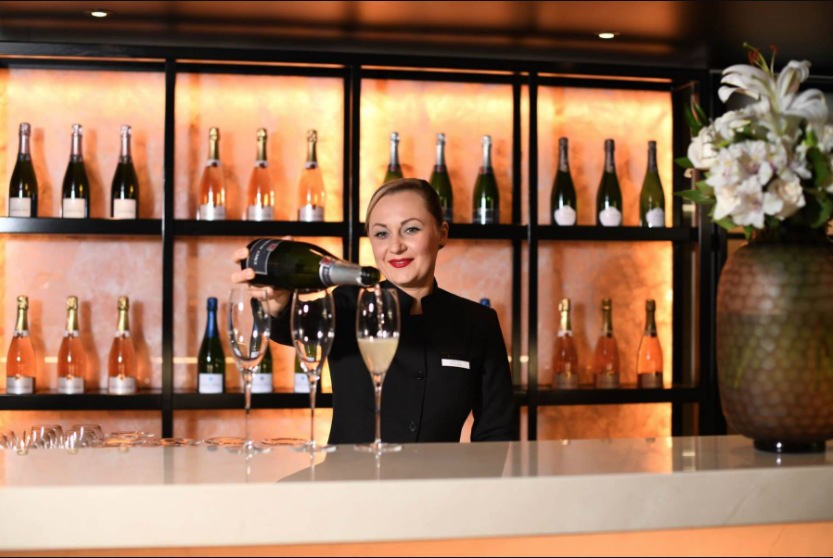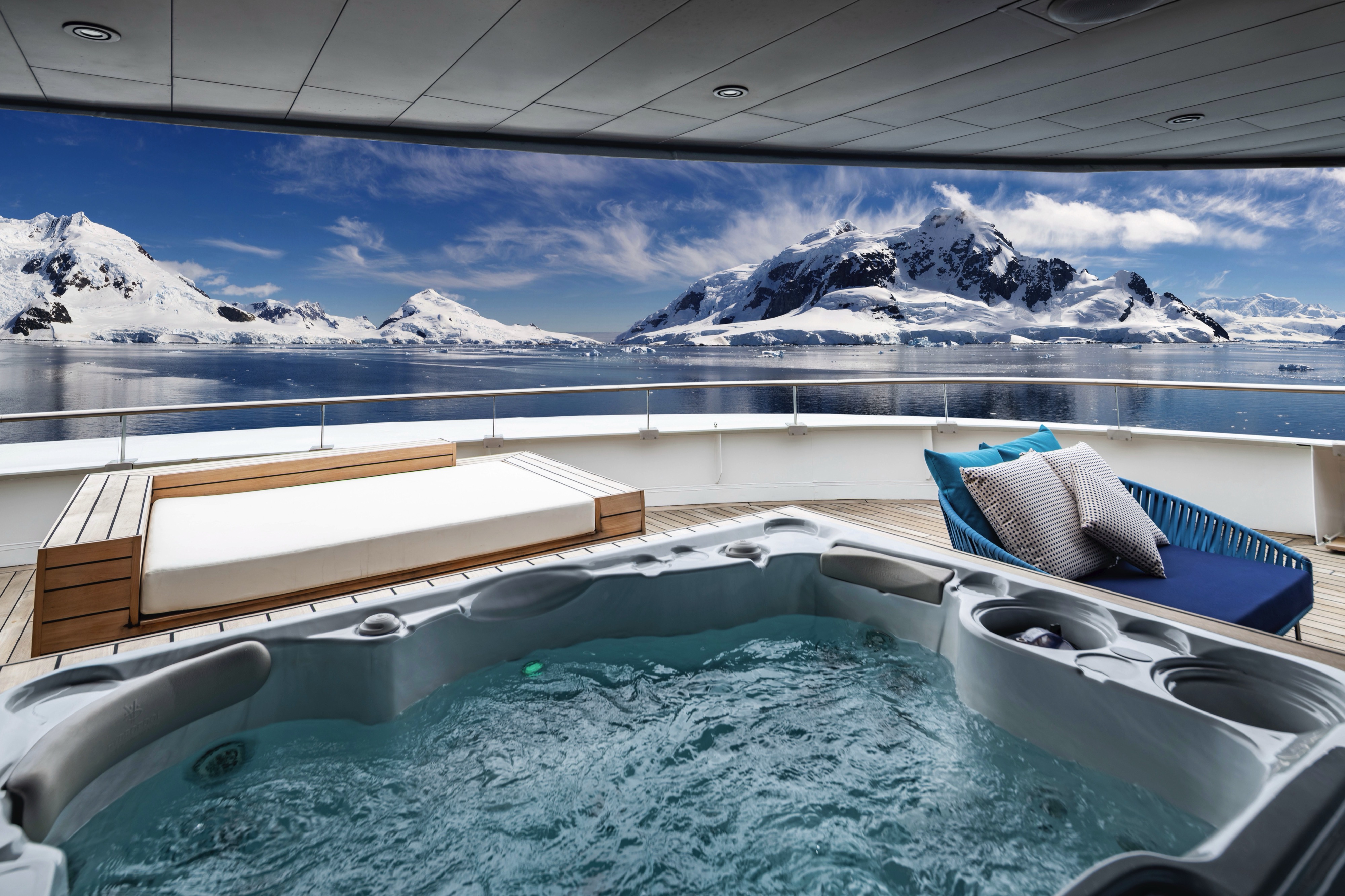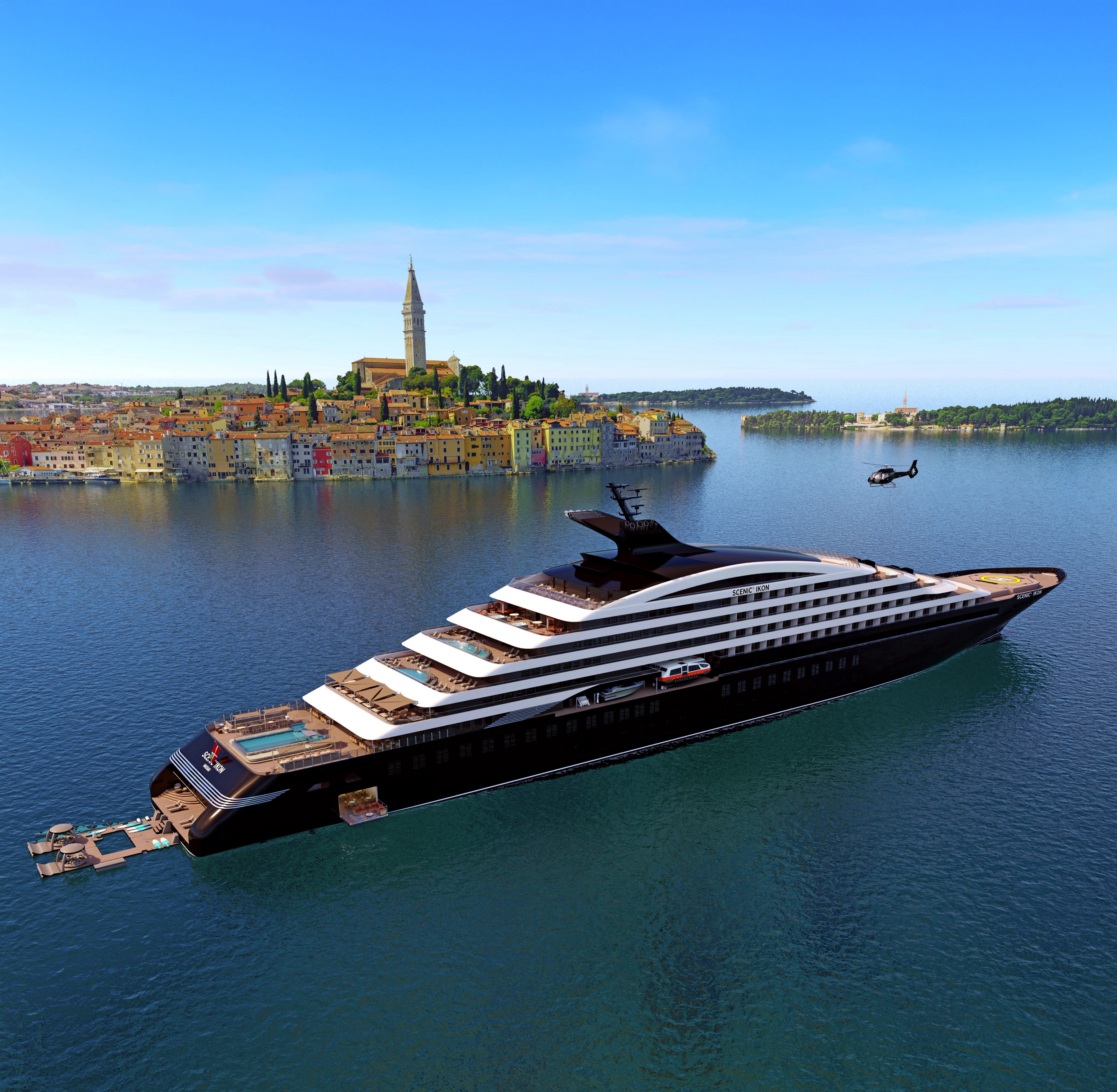Itinerary
The only city in the world that can lay claim to straddling two continents, Istanbul—once known as Constantinople, capital of the Byzantine and then the Ottoman Empire—has for centuries been a bustling metropolis with one foot in Europe and the other in Asia. Istanbul embraces this enviable position with both a certain chaos and inventiveness, ever evolving as one of the world’s most cosmopolitan crossroads. It’s often said that Istanbul is the meeting point of East and West, but visitors to this city built over the former capital of two great empires are likely to be just as impressed by the juxtaposition of old and new. Office towers creep up behind historic palaces, women in chic designer outfits pass others wearing long skirts and head coverings, peddlers’ pushcarts vie with battered old Fiats and shiny BMWs for dominance of the noisy, narrow streets, and the Grand Bazaar competes with modern shopping malls. At dawn, when the muezzin’s call to prayer resounds from ancient minarets, there are inevitably a few hearty revelers still making their way home from nightclubs and bars. Most visitors to this sprawling city of more than 14 million will first set foot in the relatively compact Old City, where the legacy of the Byzantine and Ottoman empires can be seen in monumental works of architecture like the brilliant Aya Sofya and the beautifully proportioned mosques built by the great architect Sinan. Though it would be easy to spend days, if not weeks, exploring the wealth of attractions in the historical peninsula, visitors should make sure also to venture elsewhere in order to experience the vibrancy of contemporary Istanbul. With a lively nightlife propelled by its young population and an exciting arts scene that’s increasingly on the international radar—thanks in part to its stint as the European Capital of Culture in 2010—Istanbul is truly a city that never sleeps. It’s also a place where visitors will feel welcome: Istanbul may be on the Bosphorus, but at heart it’s a Mediterranean city, whose friendly inhabitants are effusively social and eager to share what they love most about it.
Day programme:
Welcome to Istanbul, a city where East meets West in a vibrant blend of history, culture and stunning architecture. This afternoon, step on board Scenic's new, next-generation Discovery Yacht, Scenic Ikon. Your journey into wonder begins with a warm greeting from the Captain and crew. Meet your butler and settle into your spacious suite with a glass of champagne. Then join your fellow guests on deck to toast the start of an unforgettable Mediterranean cruise. Please book your flight to arrive into Istanbul prior to 02:00 PM.
The only city in the world that can lay claim to straddling two continents, Istanbul—once known as Constantinople, capital of the Byzantine and then the Ottoman Empire—has for centuries been a bustling metropolis with one foot in Europe and the other in Asia. Istanbul embraces this enviable position with both a certain chaos and inventiveness, ever evolving as one of the world’s most cosmopolitan crossroads. It’s often said that Istanbul is the meeting point of East and West, but visitors to this city built over the former capital of two great empires are likely to be just as impressed by the juxtaposition of old and new. Office towers creep up behind historic palaces, women in chic designer outfits pass others wearing long skirts and head coverings, peddlers’ pushcarts vie with battered old Fiats and shiny BMWs for dominance of the noisy, narrow streets, and the Grand Bazaar competes with modern shopping malls. At dawn, when the muezzin’s call to prayer resounds from ancient minarets, there are inevitably a few hearty revelers still making their way home from nightclubs and bars. Most visitors to this sprawling city of more than 14 million will first set foot in the relatively compact Old City, where the legacy of the Byzantine and Ottoman empires can be seen in monumental works of architecture like the brilliant Aya Sofya and the beautifully proportioned mosques built by the great architect Sinan. Though it would be easy to spend days, if not weeks, exploring the wealth of attractions in the historical peninsula, visitors should make sure also to venture elsewhere in order to experience the vibrancy of contemporary Istanbul. With a lively nightlife propelled by its young population and an exciting arts scene that’s increasingly on the international radar—thanks in part to its stint as the European Capital of Culture in 2010—Istanbul is truly a city that never sleeps. It’s also a place where visitors will feel welcome: Istanbul may be on the Bosphorus, but at heart it’s a Mediterranean city, whose friendly inhabitants are effusively social and eager to share what they love most about it.
Day programme:
Istanbul is a mesmerising city that straddles two continents. Founded by the Greeks as Byzantium in the 7th century BC, it became Constantinople under the Romans in 330 AD before falling to the Turks of the Ottoman Empire in the 1400s. Thanks to this rich and complex history, it boasts a breathtaking blend of architecture including iconic landmarks like the Hagia Sophia and Topkapi Palace. Wander the narrow lanes of the famed Grand Bazaar, savour Turkish delicacies along picturesque waterways, sip fragrant mint tea, and embrace the dynamic blend of ancient traditions and modern energy that defines this legendary destination.
Day programme:
Begin your day with a graceful sail through the legendary Dardanelles Strait, a narrow passage where history and natural beauty converge between Europe and Asia. This narrow passage links the Aegean Sea to the Sea of Marmara and is best known as the site of the Gallipoli campaign in WWI. Take in the marvellous views from the deck as you cruise past rugged shorelines, ancient ruins and rolling hills. After lunch, you’ll arrive in Kepez, ready to explore this charming seaside town. Set on the eastern coast of the Dardanelles, this popular destination comes steeped in history, with ancient sites such as the Old Town and Hadrian's Gate, and famed for its culture and culinary traditions. Kepez also offers numerous outdoor pursuits, including hiking and cycling in the surrounding parks and verdant forests, or simply relaxing on the enticing beaches.
Day programme:
Today, your yacht will arrive in Dikili, an authentic Turkish coastal town that is the modern port for the ancient city of Pergamon. Once an important cultural, scientific and political centre, the site is well known for its impressive ruins, including the famous Acropolis, ancient theatre, and the remarkable Altar of Zeus, one of the most significant archaeological sites of the Hellenistic period. Afterwards, enjoy the relaxed vibe of Dikili’s waterfront, where you can stroll along the marina or savour local Turkish cuisine at a seaside café.
Whilst the busy resort town of Kusadasi offers much in the way of shopping and dining – not to mention a flourishing beach life scene, the real jewel here is Ephesus and the stunning ruined city that really take centre stage. With only 20% of the classical ruins having been excavated, this archaeological wonder has already gained the status as Europe’s most complete classical metropolis. And a metropolis it really is; built in the 10th century BC this UNESCO World Heritage site is nothing short of spectacular. Although regrettably very little remains of the Temple of Artemis (one of the seven wonders of the ancient world), the superb Library of Celsus’ façade is practically intact and it is one of life’s great joys to attend an evening performance in the illuminated ruins once all the tourists have left. The history of the city is fascinating and multi-layered and it is well worth reading up on this beforehand if a visit is planned. Another point of interest for historians would be the house of the Virgin Mary, located on the romantically named Mount Nightingale and just nine kilometres away from Ephesus proper. Legend has it that Mary (along with St. John) spent her final years here, secluded from the rest of the population, spreading Christianity. An edifying experience, even for non-believers. For the less historical minded amongst you, Kusadasi offers plenty in the way of activities. After a stroll through the town, jump in a taxi to Ladies’ Beach (men are allowed), sample a Turkish kebap on one of the many beachfront restaurants and enjoy the clement weather. If you do want to venture further afield, then the crystal clear beaches of Guzelcamli (or the Millipark), the cave of Zeus and the white scalloped natural pools at Pamukkale, known as Cleopatra’s pools, are definitely worth a visit.
Day programme:
Wander lively bazaars and savour Turkish cuisine in the popular seaside resort town of Kusadasi. The port also serves as the gateway to the World Heritage-listed ancient city of Ephesus, renowned for its breathtaking Greco-Roman ruins dating back as far as the 10th century BC. Marvel at Ephesus’ grand Library of Celsus and the majestic ruins of the Temple of Artemis, one of the original Seven Wonders of the World, echoes of antiquity’s splendour.
Day programme:
This morning, arrive in Naxos, the largest island in the Cyclades, known for its breathtaking beaches, deep-rooted history and enchanting villages. The picturesque old town is bigger and busier than other island capitals, a tangle of steep laneways with distinctive Venetian architecture and a vibrant atmosphere. The island’s most famous site is the ancient Temple of Apollo, a vast marble gate dating back to 560 BC. Naxos perfectly blends cultural heritage with natural beauty. Whether you’re exploring historic sites, tasting local delicacies, or relaxing by the turquoise waters, Naxos offers a quintessential Greek island experience.
Undoubtedly the most extraordinary island in the Aegean, crescent-shape Santorini remains a mandatory stop on the Cycladic tourist route—even if it’s necessary to enjoy the sensational sunsets from Ia, the fascinating excavations, and the dazzling white towns with a million other travelers. Called Kállisti (the “Loveliest”) when first settled, the island has now reverted to its subsequent name of Thira, after the 9th-century-BC Dorian colonizer Thiras. The place is better known, however, these days as Santorini, a name derived from its patroness, St. Irene of Thessaloniki, the Byzantine empress who restored icons to Orthodoxy and died in 802. You can fly conveniently to Santorini, but to enjoy a true Santorini rite of passage, opt instead for the boat trip here, which provides a spectacular introduction. After the boat sails between Sikinos and Ios, your deck-side perch approaches two close islands with a passage between them. The bigger one on the left is Santorini, and the smaller on the right is Thirassia. Passing between them, you see the village of Ia adorning Santorini’s northernmost cliff like a white geometric beehive. You are in the caldera (volcanic crater), one of the world’s truly breathtaking sights: a demilune of cliffs rising 1,100 feet, with the white clusters of the towns of Fira and Ia perched along the top. The bay, once the high center of the island, is 1,300 feet in some places, so deep that when boats dock in Santorini’s shabby little port of Athinios, they do not drop anchor. The encircling cliffs are the ancient rim of a still-active volcano, and you are sailing east across its flooded caldera. On your right are the Burnt isles, the White isle, and other volcanic remnants, all lined up as if some outsize display in a geology museum. Hephaestus’s subterranean fires smolder still—the volcano erupted in 198 BC, about 735, and there was an earthquake in 1956. Indeed, Santorini and its four neighboring islets are the fragmentary remains of a larger landmass that exploded about 1600 BC: the volcano’s core blew sky high, and the sea rushed into the abyss to create the great bay, which measures 10 km by 7 km (6 mi by 4½ mi) and is 1,292 feet deep. The other pieces of the rim, which broke off in later eruptions, are Thirassia, where a few hundred people live, and deserted little Aspronissi (“White isle”). In the center of the bay, black and uninhabited, two cones, the Burnt Isles of Palea Kameni and Nea Kameni, appeared between 1573 and 1925. There has been too much speculation about the identification of Santorini with the mythical Atlantis, mentioned in Egyptian papyri and by Plato (who says it’s in the Atlantic), but myths are hard to pin down. This is not true of old arguments about whether tidal waves from Santorini’s cataclysmic explosion destroyed Minoan civilization on Crete, 113 km (70 mi) away. The latest carbon-dating evidence, which points to a few years before 1600 BC for the eruption, clearly indicates that the Minoans outlasted the eruption by a couple of hundred years, but most probably in a weakened state. In fact, the island still endures hardships: since antiquity, Santorini has depended on rain collected in cisterns for drinking and irrigating—the well water is often brackish—and the serious shortage is alleviated by the importation of water. However, the volcanic soil also yields riches: small, intense tomatoes with tough skins used for tomato paste (good restaurants here serve them); the famous Santorini fava beans, which have a light, fresh taste; barley; wheat; and white-skin eggplants.
Day programme:
One of the most photogenic islands in the world, and known for its world-famous sunsets, Santorini is simply breathtaking. Whitewashed buildings perch atop soaring cliffs, overlooking the caldera of a partially submerged ancient volcano that shaped the island with a thunderous explosion more than 3,600 years ago. The island is celebrated for the beauty of its Cycladic architecture with cubic buildings, blue-domed churches and narrow alleyways.
Having been controlled by Arabic, Venetian and Ottoman empires over the years – it’s no surprise that Heraklion is a diverse patchwork of exotic cultures and historical treasures. Celebrated as the birthplace of the Spanish Renaissance artist, El Greco, you can visit to explore the storied ruins of the Minoan empire’s capital, and unearth the rich cultural treasures that Crete’s bustling modern capital has to offer.
Day programme:
Crete’s dynamic capital is best known for its Minoan legacy. This fascinating Bronze Age civilisation has left behind a wealth of archaeological wonders, including the famed Palace of Knossos, a sprawling Minoan masterpiece. Explore the lively old town’s bustling markets, admire the historic Venetian harbour, and savour authentic Cretan cuisine and fresh seafood in charming waterfront tavernas.
Milos or Melos is a volcanic Greek island in the Aegean Sea, just north of the Sea of Crete. Milos is the southwesternmost island in the Cyclades group. The Venus de Milo and the Asclepius of Milos were both found on the island, as were a Poseidon and an archaic Apollo now in Athens.
Day programme:
Welcome to Milos, a Greek island known for its unique terrain and often referred to as the ‘Island of Colours’ thanks to its diverse soil shades. This extraordinary landscape, extending to unique rock formations of yellow, orange, red and dazzling white, appears even more dramatic set against the backdrop of sparkling turquoise waters. Milos is also famous as the original home of the iconic marble statue, Venus of Milo, an ancient sculpture believed to represent the Goddess Aphrodite and now displayed in the Louvre Museum in Paris, France.
Rising from the turquoise expanse of the sunny Mediterranean, Hydra is the counterpoint of choice for Athenians – who can swap the city chaos for blissful relaxation with an hour’s boat journey. Known for its inspiring celebrity appeal – Leonard Cohen bought a house here in the 60s – Hydra is a pretty island of rising streets, whitewash mansions, and carefree clamour. Located a stone’s throw from the Greek mainland, the authorities have resisted the temptation to cash in, meaning Hydra remains an endearing time-warp, which revels in life in the slow lane. With cars and new building developments banned – discover an island of donkeys plodding cobbled streets, and fishing boats undulating gently on the harbour’s waves.
Day programme:
Renowned for its stunning natural beauty and historic charm, this picturesque island dazzles with its rugged terrain, clear turquoise waters, and lush greenery. The main centre, also named Hydra, is a charming and bustling port town of narrow cobblestone streets and traditional, whitewashed buildings adorned with bougainvillea-covered balconies. There are no cars or motor vehicles allowed on the island, making it a peaceful and low-key getaway from the usual hustle and bustle of city life.
It’s no wonder that all roads lead to the fascinating and maddening metropolis of Athens. Lift your eyes 200 feet above the city to the Parthenon, its honey-color marble columns rising from a massive limestone base, and you behold architectural perfection that has not been surpassed in 2,500 years. But, today, this shrine of classical form dominates a 21st-century boomtown. To experience Athens—Athína in Greek—fully is to understand the essence of Greece: ancient monuments surviving in a sea of cement, startling beauty amid the squalor, tradition juxtaposed with modernity. Locals depend on humor and flexibility to deal with the chaos; you should do the same. The rewards are immense. Although Athens covers a huge area, the major landmarks of the ancient Greek, Roman, and Byzantine periods are close to the modern city center. You can easily walk from the Acropolis to many other key sites, taking time to browse in shops and relax in cafés and tavernas along the way. From many quarters of the city you can glimpse “the glory that was Greece” in the form of the Acropolis looming above the horizon, but only by actually climbing that rocky precipice can you feel the impact of the ancient settlement. The Acropolis and Filopappou, two craggy hills sitting side by side; the ancient Agora (marketplace); and Kerameikos, the first cemetery, form the core of ancient and Roman Athens. Along the Unification of Archaeological Sites promenade, you can follow stone-paved, tree-lined walkways from site to site, undisturbed by traffic. Cars have also been banned or reduced in other streets in the historical center. In the National Archaeological Museum, vast numbers of artifacts illustrate the many millennia of Greek civilization; smaller museums such as the Goulandris Museum of Cycladic Art Museum and the Byzantine and Christian Museum illuminate the history of particular regions or periods. Athens may seem like one huge city, but it is really a conglomeration of neighborhoods with distinctive characters. The Eastern influences that prevailed during the 400-year rule of the Ottoman Empire are still evident in Monastiraki, the bazaar area near the foot of the Acropolis. On the northern slope of the Acropolis, stroll through Plaka (if possible by moonlight), an area of tranquil streets lined with renovated mansions, to get the flavor of the 19th-century’s gracious lifestyle. The narrow lanes of Anafiotika, a section of Plaka, thread past tiny churches and small, color-washed houses with wooden upper stories, recalling a Cycladic island village. In this maze of winding streets, vestiges of the older city are everywhere: crumbling stairways lined with festive tavernas; dank cellars filled with wine vats; occasionally a court or diminutive garden, enclosed within high walls and filled with magnolia trees and the flaming trumpet-shaped flowers of hibiscus bushes. Formerly run-down old quarters, such as Thission, Gazi and Psirri, popular nightlife areas filled with bars and mezedopoleia (similar to tapas bars), are now in the process of gentrification, although they still retain much of their original charm, as does the colorful produce and meat market on Athinas. The area around Syntagma Square, the tourist hub, and Omonia Square, the commercial heart of the city about 1 km (½ mi) northwest, is distinctly European, having been designed by the court architects of King Otho, a Bavarian, in the 19th century. The chic shops and bistros of ritzy Kolonaki nestle at the foot of Mt. Lycabettus, Athens’s highest hill (909 feet). Each of Athens’s outlying suburbs has a distinctive character: in the north is wealthy, tree-lined Kifissia, once a summer resort for aristocratic Athenians, and in the south and southeast lie Glyfada, Voula, and Vouliagmeni, with their sandy beaches, seaside bars, and lively summer nightlife. Just beyond the city’s southern fringes is Piraeus, a bustling port city of waterside fish tavernas and Saronic Gulf views.
Day programme:
This morning, your next-generation Discovery Yacht, Scenic Ikon, will arrive in Piraeus, the vibrant port city that opens the door to the rich history and culture of Athens. Prepare to explore iconic landmarks such as the famous Acropolis, a fortified hill dominated by the Parthenon, atmospheric ruins of a white marble temple built during the height of the ancient Greek Empire. Enjoy authentic Greek cuisine and experience the lively atmosphere of this bustling ancient city.
Oraia (beautiful) is the word Greeks use to describe Nafplion. The town’s old section, on a peninsula jutting into the gulf of Argos, mixes Greek, Venetian, and Turkish architecture; narrow streets, often just broad flights of stone stairs, climb the slopes beneath the walls of Acronafplia. Tree-shaded plazas surround neoclassic buildings. The Palamidi fortress—an elegant display of Venetian might from the early 1700s—guards the town. Nafplion deserves at least a leisurely day of your undivided attention, and you may want to spend several days or a week here and use the city as the base from which to explore the many surrounding ancient sights.
Day programme:
Discover the rich tapestry of history as you wander through Nafplion’s charming streets adorned with neoclassical architecture, Venetian fortresses and Turkish mosques. Explore the winding alleys of the Old Town, where traditional tavernas and quaint cafes beckon you to indulge in local delicacies. Climb the steps to Palamidi Fortress for breathtaking views of the town and sea below or relax on the shores of Arvanitia Beach. See the World Heritage-listed Epidaurus Theatre and archaeological site of Mycenae, dating back to the second century BC.
Corfu town today is a vivid tapestry of cultures—a sophisticated weave, where charm, history, and natural beauty blend. Located about midway along the island’s east coast, this spectacularly lively capital is the cultural heart of Corfu and has a remarkable historic center that UNESCO designated as a World Heritage Site in 2007. All ships and planes dock or land near Corfu town, which occupies a small peninsula jutting into the Ionian Sea.Whether arriving by ferry from mainland Greece or Italy, from another island, or directly by plane, catch your breath by first relaxing with a coffee or a gelato in Corfu town’s shaded Liston Arcade, then stroll the narrow lanes of its pedestrians-only quarter. For an overview of the immediate area, and a quick tour of Mon Repos palace, hop on the little tourist train that runs from May to September. Corfu town has a different feel at night, so book a table at one of its famed tavernas to savor the island’s unique cuisine.The best way to get around Corfu town is on foot. The town is small enough so that you can easily walk to every sight. There are local buses, but they do not thread their way into the streets (many now car-free) of the historic center. If you are arriving by ferry or plane, it’s best to take a taxi to your hotel. Expect to pay about €10 from the airport or ferry terminal to a hotel in Corfu town. If there are no taxis waiting, you can call for one.
Day programme:
The ruggedly beautiful island of Corfu is dotted with whitewashed houses and olive groves, creating an enchanting Mediterranean allure. The World Heritage-listed Old Town boasts a rich history and stunning Renaissance and Baroque architecture. Wander the vibrant Spianada, Greece’s largest square, and immerse yourself in Corfu’s timeless charm and cultural treasures.
Day programme:
A true gem of the Adriatic, Monopoli charms with its whitewashed buildings, vibrant fishing port and maze of narrow streets. Wander the historic old town, explore magnificent churches, or unwind by the sea with a gelato in hand. This coastal town captures the heart of Puglia in every detail.
Backed by imposing mountains, tiny Kotor lies hidden from the open sea, tucked into the deepest channel of the Bokor Kotorska (Kotor Bay), which is Europe’s most southerly fjord. To many, this town is more charming than its sister UNESCO World Heritage Site, Dubrovnik, retaining more authenticity, but with fewer tourists and spared the war damage and subsequent rebuilding which has given Dubrovnik something of a Disney feel.Kotor’s medieval Stari Grad (Old Town) is enclosed within well-preserved defensive walls built between the 9th and 18th centuries and is presided over by a proud hilltop fortress. Within the walls, a labyrinth of winding cobbled streets leads through a series of splendid paved piazzas, rimmed by centuries-old stone buildings. The squares are now haunted by strains from buskers but although many now house trendy cafés and chic boutiques, directions are still given medieval-style by reference to the town’s landmark churches.In the Middle Ages, as Serbia’s chief port, Kotor was an important economic and cultural center with its own highly regarded schools of stonemasonry and iconography. From 1391 to 1420 it was an independent city-republic and later, it spent periods under Venetian, Austrian, and French rule, though it was undoubtedly the Venetians who left the strongest impression on the city’s architecture. Since the breakup of Yugoslavia, some 70% of the stone buildings in the romantic Old Town have been snapped up by foreigners, mostly Brits and Russians. Porto Montenegro, a new marina designed to accommodate some of the world’s largest super yachts, opened in nearby Tivat in 2011, and along the bay are other charming seaside villages, all with better views of the bay than the vista from Kotor itself where the waterside is congested with cruise ships and yachts. Try sleepy Muo or the settlement of Prčanj in one direction around the bay, or Perast and the Roman mosaics of Risan in the other direction.
Day programme:
Today, arrive in Kotor, a fortified city nestled between towering mountains and the shimmering Adriatic. This World Heritage-listed town is brimming with Venetian palaces, cobblestone lanes and café-hemmed squares. Guarded by medieval walls, Kotor is a place of ancient stories and modern culture.As your next-generation Discovery Yacht departs, enjoy the breathtaking sail away through the Bay of Kotor, Europe’s southernmost fjord-like bay, with its rugged mountain backdrop and charming, red-roofed villages lining the shores.In the evening, you’ll sail on to Dubrovnik, where your ship will stay overnight, giving you ample time to soak in the city's medieval charm and vibrant evening atmosphere.
Nothing can prepare you for your first sight of Dubrovnik. Lying 216 km (135 miles) southeast of Split and commanding a jaw-dropping coastal location, it is one of the world’s most beautiful fortified cities. Its massive stone ramparts and fortress towers curve around a tiny harbor, enclosing graduated ridges of sun-bleached orange-tiled roofs, copper domes, and elegant bell towers. Your imagination will run wild picturing what it looked like seven centuries ago when the walls were built, without any suburbs or highways around it, just this magnificent stone city rising out of the sea.In the 7th century AD, residents of the Roman city Epidaurum (now Cavtat) fled the Avars and Slavs of the north and founded a new settlement on a small rocky island, which they named Laus, and later Ragusa. On the mainland hillside opposite the island, the Slav settlement called Dubrovnik grew up. In the 12th century the narrow channel separating the two settlements was filled in (now the main street through the Old Town, called Stradun), and Ragusa and Dubrovnik became one. The city was surrounded by defensive walls during the 13th century, and these were reinforced with towers and bastions in the late 15th century.From 1358 to 1808 the city thrived as a powerful and remarkably sophisticated independent republic, reaching its golden age during the 16th century. In 1667 many of its splendid Gothic and Renaissance buildings were destroyed by an earthquake. The defensive walls survived the disaster, and the city was rebuilt in baroque style.Dubrovnik lost its independence to Napoléon in 1808, and in 1815 passed to Austria-Hungary. During the 20th century, as part of Yugoslavia, the city became a popular tourist destination, and in 1979 it was listed as a UNESCO World Heritage Site. During the war for independence, it came under heavy siege. Thanks to careful restoration, few traces of damage remain; however, there are maps inside the Pile and Ploče Gates illustrating the points around the city where damage was done. It’s only when you experience Dubrovnik yourself that you can understand what a treasure the world nearly lost
Nothing can prepare you for your first sight of Dubrovnik. Lying 216 km (135 miles) southeast of Split and commanding a jaw-dropping coastal location, it is one of the world’s most beautiful fortified cities. Its massive stone ramparts and fortress towers curve around a tiny harbor, enclosing graduated ridges of sun-bleached orange-tiled roofs, copper domes, and elegant bell towers. Your imagination will run wild picturing what it looked like seven centuries ago when the walls were built, without any suburbs or highways around it, just this magnificent stone city rising out of the sea.In the 7th century AD, residents of the Roman city Epidaurum (now Cavtat) fled the Avars and Slavs of the north and founded a new settlement on a small rocky island, which they named Laus, and later Ragusa. On the mainland hillside opposite the island, the Slav settlement called Dubrovnik grew up. In the 12th century the narrow channel separating the two settlements was filled in (now the main street through the Old Town, called Stradun), and Ragusa and Dubrovnik became one. The city was surrounded by defensive walls during the 13th century, and these were reinforced with towers and bastions in the late 15th century.From 1358 to 1808 the city thrived as a powerful and remarkably sophisticated independent republic, reaching its golden age during the 16th century. In 1667 many of its splendid Gothic and Renaissance buildings were destroyed by an earthquake. The defensive walls survived the disaster, and the city was rebuilt in baroque style.Dubrovnik lost its independence to Napoléon in 1808, and in 1815 passed to Austria-Hungary. During the 20th century, as part of Yugoslavia, the city became a popular tourist destination, and in 1979 it was listed as a UNESCO World Heritage Site. During the war for independence, it came under heavy siege. Thanks to careful restoration, few traces of damage remain; however, there are maps inside the Pile and Ploče Gates illustrating the points around the city where damage was done. It’s only when you experience Dubrovnik yourself that you can understand what a treasure the world nearly lost
Day programme:
Known as the ‘Pearl of the Adriatic’, Dubrovnik is a compelling historic city along Croatia's Dalmatian Coast. Its walled Old Town is one of the finest examples of medieval citadel architecture in Europe. With its storied history and breathtaking views of iconic terracotta rooftops and the alluring Adriatic Sea, Dubrovnik offers the perfect blend of cultural exploration and serene seaside strolls.
Off the coast of Croatia in the southern Adriatic Sea lie some thousand islands and the largest of them, Korçula, is considered the most beautiful. With an average of 3,000 hours of sunshine per annum, which guarantees a wide assortment of Mediterranean vegetation, it is not difficult to understand why seasoned travelers compare Korçula to a latter-day Eden. Separated from the mainland by a channel of only one mile, Korçula’s main town, named the same as the island, ranks among the best preserved medieval towns in the Mediterranean. It is the island’s main tourist, economic and cultural center. Thanks to its strategic location along the sea trade routes, Korçula has always attracted travelers and settlers. Korcula was founded by Greek colonists, who were followed by Illyrians, Romans and finally the Croats. The Korçula Statute of 1214 is one of the oldest legal documents to have been adopted in this part of Europe. The same century saw the birth of the famous world traveler, Marco Polo. The house said to be his birthplace can be seen in town. Korçulans have always been known as keen seafarers, excellent shipbuilders, stonemasons and artists. From their many voyages, sailors brought back new ideas, which eventually mixed with local customs. To this day, Korçula has maintained the tradition of performing knightly games such as the chivalrous Moreska dance, which has been in existence for more than 400 years. Visitors to Korçula enjoy its stunning location, natural beauty and medieval ambiance. And if that’s not enough, the town offers numerous attractions that are within walking distance from the pier, including the City Museum and the Bishop’s Treasury.
Day programme:
Korcula, Croatia, is the Adriatic’s sixth-largest island and has been dubbed the ‘Emerald Isle’ for its lush, green landscape. It is renowned for its medieval Old Town, often called ‘Little Dubrovnik’. Famed as Marco Polo’s birthplace, it boasts Gothic-Renaissance architecture and quaint squares, whilst vineyards grace nearby Cara and Smokvica, yielding the prized Croatian wine, Pošip.
Šibenik’s main monument, its Gothic-Renaissance cathedral, built of pale-gray Dalmatian stone and designated a UNESCO World Heritage Site, stands on a raised piazza close to the seafront promenade. From here a network of narrow, cobbled streets leads through the medieval quarter of tightly packed, terra-cotta–roof houses, and up to the ruins of a 16th-century hilltop fortress. The city has never been a real tourist destination. Before the Croatian war for independence, it was a relatively prosperous industrial center, but when the factories closed, Šibenik sank into an economic depression. However, the cathedral more than warrants a look, and it makes a decent base for visiting the waterfalls of Krka National Park.
Day programme:
Šibenik, a Dalmatian treasure, was founded in the ninth century and is one of the oldest Croatian cities on the Adriatic. It’s famous for the World Heritage-listed Cathedral of St. James, a Renaissance masterpiece as well as medieval fortresses like St. Michael’s and the winding cobblestone alleys of its car-free Old Town. It also neighbours Krka National Park, home to a series of seven stunning waterfalls.
Day programme:
Piran, a lesser-known coastal gem on Slovenia’s Adriatic shore, enchants with its medieval charm. Clustered on the Piran peninsula, its red-tiled, white-washed buildings reflect a vibrant Venetian heritage, shaped by the Venetian empire from the late 13th to late 18th century. Elegant gothic-style architecture and narrow cobblestone streets invite exploration.
Venice is a city unlike any other. No matter how often you’ve seen it in photos and films, the real thing is more dreamlike than you could imagine. With canals where streets should be, water shimmers everywhere. The fabulous palaces and churches reflect centuries of history in what was a wealthy trading center between Europe and the Orient. Getting lost in the narrow alleyways is a quintessential part of exploring Venice, but at some point you’ll almost surely end up in Piazza San Marco, where tourists and locals congregate for a coffee or an aperitif.
Day programme:
Arriving in Venice by luxurious yacht is pure magic, a stunning introduction to a city where enchanting canals, rich culture, and timeless beauty await your discovery. Stroll through St. Mark’s Square, admire the artistry of the Doge’s Palace, glide along quiet canals by gondola, or simply lose yourself in the charm of hidden alleyways and artisan boutiques.
One of the true jewels of the Mediterranean, Rovinj is a jaw-droppingly beautiful town, which juts out into sparkling Mediterranean. Dominated by the pencil-like bell tower of the Venetian Saint Euphemia Cathedral, pine tree forests flow to the borders of the quaint Old Town – which evokes the romantic, tangled backstreets of the Venice. Rovinj – or Rovino in Italian – is a city of split personalities, with two official languages – having been owned by the Kingdom of Italy between 1919 and 1947.
Day programme:
Today, explore Rovinj, a picturesque coastal town on Croatia’s Istrian Peninsula. Known for its charming old town with cobblestone streets, colourful buildings and a bustling harbour, Rovinj offers a perfect blend of history, culture, and seaside beauty. Wander through quaint alleys, visit the hilltop Church of St. Euphemia, and enjoy a coffee at one of the vibrant cafés along the waterfront.
Dalmatia’s capital for more than 1,000 years, Zadar is all too often passed over by travelers on their way to Split or Dubrovnik. What they miss out on is a city of more than 73,000 that is remarkably lovely and lively despite—and, in some measure, because of—its tumultuous history. The Old Town, separated from the rest of the city on a peninsula some 4 km (2½ miles) long and just 1,640 feet wide, is bustling and beautiful: the marble pedestrian streets are replete with Roman ruins, medieval churches, palaces, museums, archives, and libraries. Parts of the new town are comparatively dreary, a testament to what a world war followed by decades of communism, not to mention a civil war, can do to the architecture of a city that is 3,000 years old. A settlement had already existed on the site of the present-day city for some 2,000 years when Rome finally conquered Zadar in the 1st century BC; the foundations of the forum can be seen today. Before the Romans came the Liburnians had made it a key center for trade with the Greeks and Romans for 800 years. In the 3rd century BC the Romans began to seriously pester the Liburnians, but required two centuries to bring the area under their control. During the Byzantine era, Zadar became the capital of Dalmatia, and this period saw the construction of its most famous church, the 9th-century St. Donat’s Basilica. It remained the region’s foremost city through the ensuing centuries. The city then experienced successive onslaughts and occupations—both long and short—by the Osogoths, the Croatian-Hungarian kings, the Venetians, the Turks, the Habsburgs, the French, the Habsburgs again, and finally the Italians before becoming part of Yugoslavia and, in 1991, the independent republic of Croatia. Zadar was for centuries an Italian-speaking city, and Italian is still spoken widely, especially by older people. Indeed, it was ceded to Italy in 1921 under the Treaty of Rapallo (and reverted to its Italian name of Zara). Its occupation by the Germans from 1943 led to intense bombing by the Allies during World War II, which left most of the city in ruins. Zadar became part of Tito’s Yugoslavia in 1947, prompting many Italian residents to leave. Zadar’s most recent ravages occurred during a three-month siege by Serb forces and months more of bombardment during the Croatian-Serbian war between 1991 and 1995. But you’d be hard-pressed to find outward signs of this today in what is a city to behold. There are helpful interpretive signs in English all around the Old Town, so you certainly won’t feel lost when trying to make sense of the wide variety of architectural sites you might otherwise pass by with only a cursory look.
Day programme:
Discover Zadar, a vibrant city on the Dalmatian Coast where history meets the sea. Enjoy a walk along the waterfront to hear the sounds of the Sea Organ, a unique wave-powered creation; explore the charming old town filled with ancient Roman ruins and lively streets, and take in the beautiful views that make this a truly special destination.
The Croatian island of Hvar bills itself as the “sunniest island in the Adriatic.” Not only does it have the figures to back up this claim—an annual average of 2,724 hours of sunshine—but it also makes visitors a sporting proposition, offering them a money-back guarantee if there are seven consecutive days of snow (snow has been known to fall here; the last time being February 2012).
Day programme:
Explore Hvar, Dalmatia’s gem, founded as Pharos in the fourth century BC. Admire its vibrant Pjaca (main town square) and ornate Venetian architecture, and inhale the scent of the nearby fragrant lavender fields. The sunniest spot in Croatia and consistently ranked among the world’s most popular islands, Hvar captivates with stunning beauty surrounded by the deep blues of the Adriatic Sea.
Siracusa, known to English speakers as Syracuse, is a wonder to behold. One of the great ancient capitals of Western civilization, the city was founded in 734 BC by Greek colonists from Corinth and soon grew to rival, and even surpass, Athens in splendor and power. It became the largest, wealthiest city-state in the West and a bulwark of Greek civilization. Although Siracusa lived under tyranny, rulers such as Dionysius filled their courts with Greeks of the highest cultural stature—among them the playwrights Aeschylus and Euripides, and the philosopher Plato. The Athenians, who didn’t welcome Siracusa’s rise, set out to conquer Sicily, but the natives outsmarted them in what was one of the greatest military campaigns in ancient history (413 BC). The city continued to prosper until it was conquered two centuries later by the Romans.Present-day Siracusa still has some of the finest examples of Baroque art and architecture; dramatic Greek and Roman ruins; and a Duomo that’s the stuff of legend—a microcosm of the city’s entire history in one building. The modern city also has a wonderful, lively, Baroque old town worthy of extensive exploration, as well as pleasant piazzas, outdoor cafés and bars, and a wide assortment of excellent seafood. There are essentially two areas to explore in Siracusa: the Parco Archeologico (Archaeological Zone), on the mainland; and the island of Ortygia, the ancient city first inhabited by the Greeks, which juts out into the Ionian Sea and is connected to the mainland by two small bridges. Ortygia is becoming increasingly popular with tourists, and is starting to lose its old-fashioned charm in favor of modern boutiques.Siracusa’s old nucleus of Ortygia, a compact area, is a pleasure to amble around without getting unduly tired. In contrast, mainland Siracusa is a grid of wider avenues. At the northern end of Corso Gelone, above Viale Paolo Orsi, the orderly grid gives way to the ancient quarter of Neapolis, where the sprawling Parco Archeologico is accessible from Viale Teracati (an extension of Corso Gelone). East of Viale Teracati, about a 10-minute walk from the Parco Archeologico, the district of Tyche holds the archaeological museum and the church and catacombs of San Giovanni, both off Viale Teocrito (drive or take a taxi or city bus from Ortygia). Coming from the train station, it’s a 15-minute trudge to Ortygia along Via Francesco Crispi and Corso Umberto. If you’re not up for that, take one of the free electric buses leaving every 10 minutes from the bus station around the corner.
Day programme:
Spend the day in the city of Syracuse on the Ionian coast of the island of Sicily, a tapestry of lush citrus orchards, golden stone buildings and sparkling blue seas. Explore the remnants of ancient civilisations in the Archaeological Park of Neapolis, where the Greek Theatre and Roman Amphitheatre stand as testaments to the city's rich history. Stroll through the charming streets of Ortigia, the historic heart of Syracuse, with its baroque architecture and bustling markets. Indulge in authentic Sicilian cuisine at traditional waterfront trattorias, savouring local delicacies like arancini and cannoli.
Day programme:
Known as the ‘Jewel of Sicily’, Taormina is one of Sicily’s most popular resort towns. Once a stop on the famed Grand Tour of the 19th century, today it is synonymous with luxury hotels, exceptional restaurants and designer boutiques. It’s also the gateway to World Heritage-listed Mount Etna, the largest active volcano in Europe, which dominates the picturesque backdrop. This charming small town set high above the Ionian Sea is known for its ancient Greco-Roman theatre, beautifully restored medieval buildings, astonishing vistas and exclusive atmosphere.
Once the intellectual capital of southern Europe, Palermo has always been at the crossroads of civilization. Favorably situated on a crescent-shaped bay at the foot of Monte Pellegrino, it has attracted almost every culture touching the Mediterranean world. To Palermo’s credit, it has absorbed these diverse cultures into a unique personality that is at once Arab and Christian, Byzantine and Roman, Norman and Italian. The city’s heritage encompasses all of Sicily’s varied ages, but its distinctive aspect is its Arab-Norman identity, an improbable marriage that, mixed in with Byzantine and Jewish elements, created some resplendent works of art. No less noteworthy than the architecture is Palermo’s chaotic vitality, on display at some of Italy’s most vibrant outdoor markets, public squares, street bazaars, and food vendors, and above all in its grand climax of Italy’s most spectacular passeggiata (the leisurely social stroll along the principal thoroughfare).
Day programme:
Welcome to Palermo, a vibrant and historic city located on the northern coast of Sicily. The island’s capital reveals a mix of cultures, including Italian, Arabic, and Norman influences, which is evident in its diverse architectural styles and cuisine. Palermo's historic centre is a World Heritage-listed site, brimming with beautiful churches, royal palaces, and bustling squares. Palermo is also known for its street food scene, with markets like Mercato Ballarò and Mercato Vucciria serving up a wide range of local specialties, such as arancini, panelle, and sfincione.
The largest and most developed of the Aeolians, Lipari welcomes you with distinctive pastel-color houses. Fields of spiky agaves dot the northernmost tip of the island, Acquacalda, indented with pumice and obsidian quarries. In the west is San Calogero, where you can explore hot springs and mud baths. From the red-lava base of the island rises a plateau crowned with a 16th-century castle and a 17th-century cathedral.
Day programme:
The World Heritage-listed Aeolian Islands are seven volcanic outcrops set off the north coast of Sicily with a rich history dating back to 5000 BC. As you sail into the islands this morning, look out for the huge rock formations that rise dramatically from the water. Lipari is the largest and most popular of the islands, known for its pebbled beaches, hiking trails and historic harbour. From its panoramic position, a castle overlooks the seafront of pastel-coloured townhouses, with windswept highlands and steep cliffs in the distance.
At first glance, it’s hard to imagine that this resort destination was one of the world’s great naval powers, and a sturdy rival of Genoa and Pisa for control of the Mediterranean in the 11th and 12th centuries. Once the seat of the Amalfi Maritime Republic, the town is set in a verdant valley of the Lattari Mountains, with cream-colored and pastel-hued buildings tightly packing a gorge on the Bay of Salerno. The harbor, which once launched the greatest fleet in Italy, now bobs with ferries and blue-and-white fishing boats. The main street, lined with shops and pasticcerie, has replaced a raging mountain torrent, and terraced hills flaunt the green and gold of lemon groves. Bearing testimony to its great trade with Tunis, Tripoli, and Algiers, Amalfi remains honeycombed with Arab-Sicilian cloisters and covered passages. In a way Amalfi has become great again, showing off its medieval glory days with sea pageants, convents-turned-hotels, ancient paper mills, covered streets, and its glimmering cathedral.
Day programme:
This morning you’ll arrive in the historic town of Amalfi, which gave this region its name. Nestled between mountains and the sea, Amalfi was one of the four Maritime Republics of Italy in the Middle Ages, bringing great wealth and power. Wander along its meandering alleyways to admire historic buildings, grand churches and ornate fountains, or just relax at one of the many cafes that spill out onto the street. The nearby village of Ravello offers spectacular views of the Bay of Salerno and peaceful gardens surrounding medieval ruins.
Tour description Capri, Italy Popular since Roman times when the emperors built their villas on Capri, this island is surely one of the world’s most famous and beautiful spots. Visiting Capri, it is easy to see why the ancient Romans fell in love with this place 2,000 years ago – the craggy mountains, the sea caves and grottos and the brilliantly colored flowers cast a magic spell then and still capture the admiration of today’s travelers. There are sleek yachts moored in the deep blue waters of the bays, and beautiful villas and tiny villages cling to steep slopes. An excellent year-round climate and a breathtaking landscape complete the picture of a storybook island. There are two main villages – Capri Town, site of the popular meeting point “Piazzetta,” and Anacapri, the upper town, dominated by 1,750-foot-high Monte Solaro, the highest point on the island. Both remain the “in” scene for international travelers. By spending millions on comfort and style, the island has ensured its continuing success. After a trip to upper-level Anacapri, visitors enjoy strolling the narrow, cobbled streets of Capri Town, browsing in chic boutiques and spending time in the Piazzetta with a drink in one of the outdoor cafés. There is a funicular from the main port of Marina Grande to Capri Town; from Anacapri, a chair lift whisks visitors to the top of Monte Solaro for a spellbinding view. The magical Blue Grotto can be reached by boat from Marina Grande, but entrance into the grotto depends for the most part on sea conditions. Please Note: For your convenience, the shore excursions offered for this port of call are available to reserve in advance at www.silversea.com until August 8 , as well as offered for purchase on board, unless otherwise noted in the description. Going Ashore in Capri Pier Information The ship is scheduled to anchor off Capri’s main port, Marina Grande. Guests will be taken ashore via local tenders, arriving at the pier just a short distance from the funicular to Capri Town. Taxis and minibuses are also available near the pier area. Be sure to agree on the fare before starting out. Shopping Capri is a shopping mecca, though by no means inexpensive. Upscale shops and boutiques offer an array of jewelry, designer fashions, resort wear, straw articles and souvenir items. Start from the Piazzetta and the streets fanning out from the square. Some shops may be closed between 12:30/1:00 p.m. and 4:00/4:30 p.m. The local currency is the euro. Cuisine Capri features plenty of open-air eateries in addition to top rated restaurants. Fresh seafood and delicious pasta dishes make for a nice lunch; for a quick meal there are tempting sandwiches and pizza. You might enjoy a hearty Italian table wine with lunch. Other Sights Capri Town La Piazzetta is the main square of Capri Town located just opposite the upper funicular station. The square is an ideal place from where to start exploring or shopping. Sidewalk cafés around the square provide residents and visitors with a popular pastime – people-watching while sipping a drink or enjoying a coffee. Anacapri Reaching Capri’s second town is via local minibus. In addition to numerous souvenir shops and designer boutiques, attractions include Axel Munthe’s Villa San Michele and the chair lift to Monte Solaro. Blue Grotto Boat excursions to the Blue Grotto can be booked locally at Marina Grande. Be aware that it is necessary to transfer into smaller boats in front of the grotto. Also, entrance to the grotto is subject to weather and sea conditions. For this reason, tours to the Blue Grotto are frequently cancelled. Private arrangements are not available in this port.
Day programme:
Capri’s mythic charm has captured hearts for more than 2,000 years. Roman Emperor Caesar Augustus fell in love with the island in 29 BC, building villas, temples and gardens for his own private paradise. Today, its jaw-dropping beauty still draws royalty, celebrities and fashionable travellers from all over the world. Wander through the Piazzetta and listen to the melodious chiming of the clock tower, admire the impossibly blue ocean as it crashes onto the cliffs, and taste its famous flourless chocolate cake or a fresh caprese salad.
Italy’s vibrant capital lives in the present, but no other city on earth evokes its past so powerfully. For over 2,500 years, emperors, popes, artists, and common citizens have left their mark here. Archaeological remains from ancient Rome, art-stuffed churches, and the treasures of Vatican City vie for your attention, but Rome is also a wonderful place to practice the Italian-perfected il dolce far niente, the sweet art of idleness. Your most memorable experiences may include sitting at a caffè in the Campo de’ Fiori or strolling in a beguiling piazza.
Day programme:
Your Signature Yacht Cruise concludes this morning in Civitavecchia, an ancient port dating back to the second century and the gateway to Rome. Explore the timeless beauty of Rome, the Eternal City, where historic monuments and ornate churches sit alongside busy cafes and famous designer boutiques, and every corner tells a story of empires past. After savouring a final breakfast on board, it will be time to disembark and commence your onward journey or return home, carrying cherished memories with you. Please book your flight to depart out of Rome after 12:00 PM.#Spa treatments and services at additional cost. Daily activities may be subject to change; please consult your Daily Wonder for updates. +All drinks on board, including those stocked in your mini bar, are included, except for a very small number of rare, fine and vintage wines, Champagnes and spirits. Specialty restaurants require a reservation, enquire on board.^Experiences on board our helicopters and submersible are at additional cost, subject to regulatory approval, availability, weight restrictions, medical approval and weather conditions.Submersible not operational in Europe.The itinerary is a guide only and may be amended for operational reasons. As such Scenic cannot guarantee the voyage will operate unaltered from the itinerary stated above. Please refer to our terms and conditions for further information.
Ship features

Ikon Penthouse
Your own private residence at sea.
The lounge is thoughtfully appointed areas for relaxation, dining, and entertaining, with a fully appointed bar island: delight in anything your heart desires — from crafted cocktails to wellness-inspired refreshments and light dining — all served discreetly by your private butler. The suite features a master bedroom plus a wellness studio with in-suite ESPA spa services and private fitness amenities. Which can transform into a second bedroom for family or guests. The bathroom is enhanced with steam and infrared experiences for ultimate wellbeing and indulgence with full-size baths and double vanities, ensuring the utmost in comfort and indulgence. A spacious walk-in wardrobe and private Glam Bar, fully appointed with Dyson’s advanced hair care tools and elevated ESPA amenities, complete the suite, offering effortless luxury and the ultimate in oceanfront living. An expansive terrace with Jacuzzi, private cabana, and outdoor lounge and dining areas provides the perfect space to relax or entertain under open skies.

Grand Terrace Suite
Enjoy enhanced space and bespoke amenities. Each suite features spacious walk-in wardrobes and Glam Bars. These top-tier suites further elevate indulgence with expansive, fully appointed Butler Bars, offering a personalised selection of refreshments and in-suite dining options. Full-size bath, double vanity, Glam bar, and elevated ESPA amenities, delivering unparalleled comfort and refined ultra-luxury. A private terrace with jacuzzi, cabana and dining.
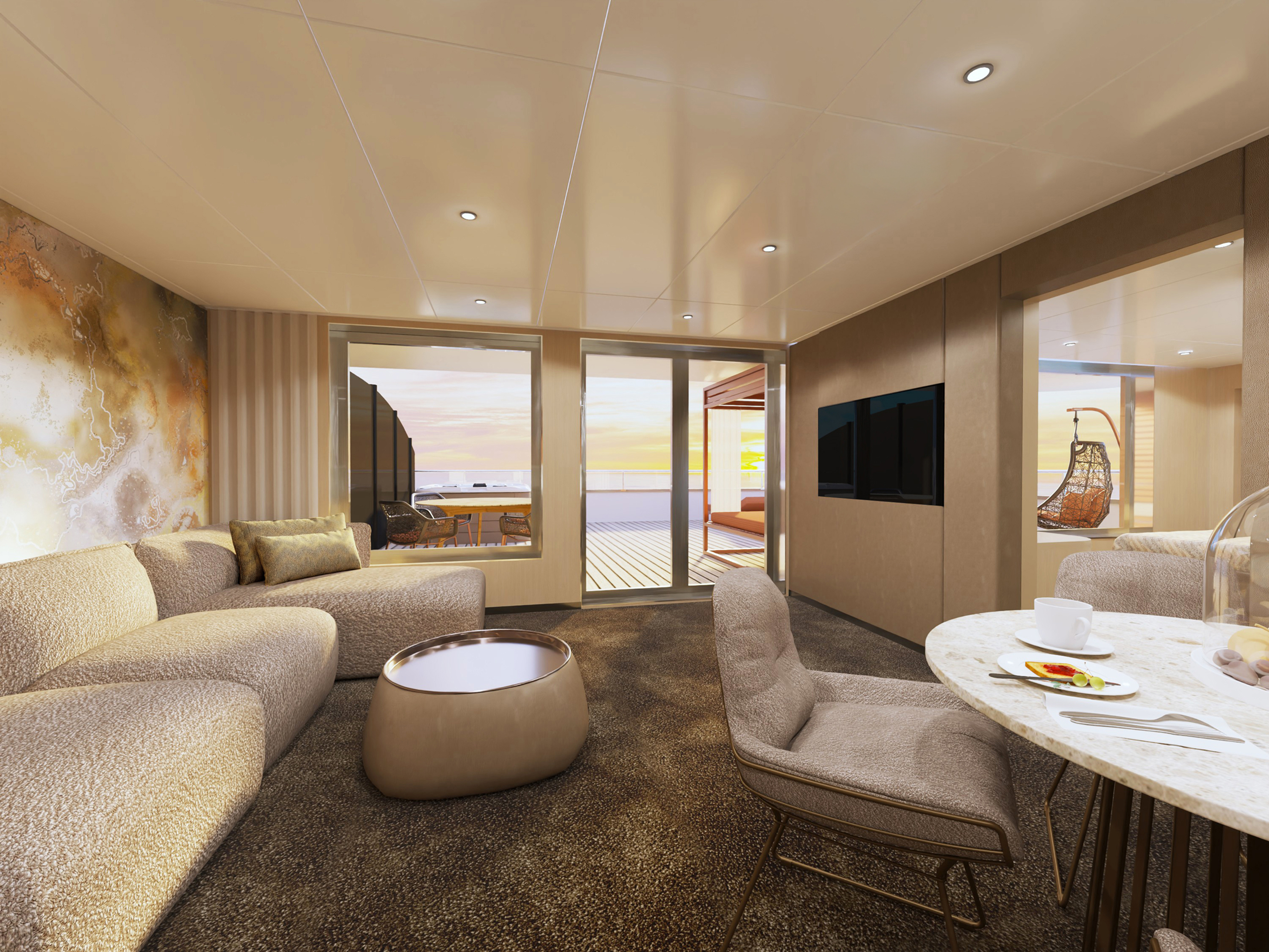
Scenic Yacht Suite
Enjoy enhanced space and bespoke amenities. Each suite features spacious walk-in wardrobes and Glam Bars. These top-tier suites further elevate indulgence with expansive, fully appointed Butler Bars, offering a personalised selection of refreshments and in-suite dining options. Full-size bath, double vanity, Glam bar, and elevated ESPA amenities, delivering unparalleled comfort and refined ultra-luxury. A private terrace with jacuzzi, cabana and dining.

Horizon Suite
Separate bedroom for enhanced privacy. Full-size bath, double vanity, walk-in wardrobe, and Glam Bar, ensuring every detail is designed for comfort, privacy, and indulgence.

Signature Spa Suite
A romantic retreat for couples, featuring a luxurious four-poster bed and indulgent wellness bathroom with a soaking spa bath, steam shower, soothing light therapy, and ocean vista, double vanity, and elevated ESPA spa amenities. Every detail is designed for shared relaxation and rejuvenation.
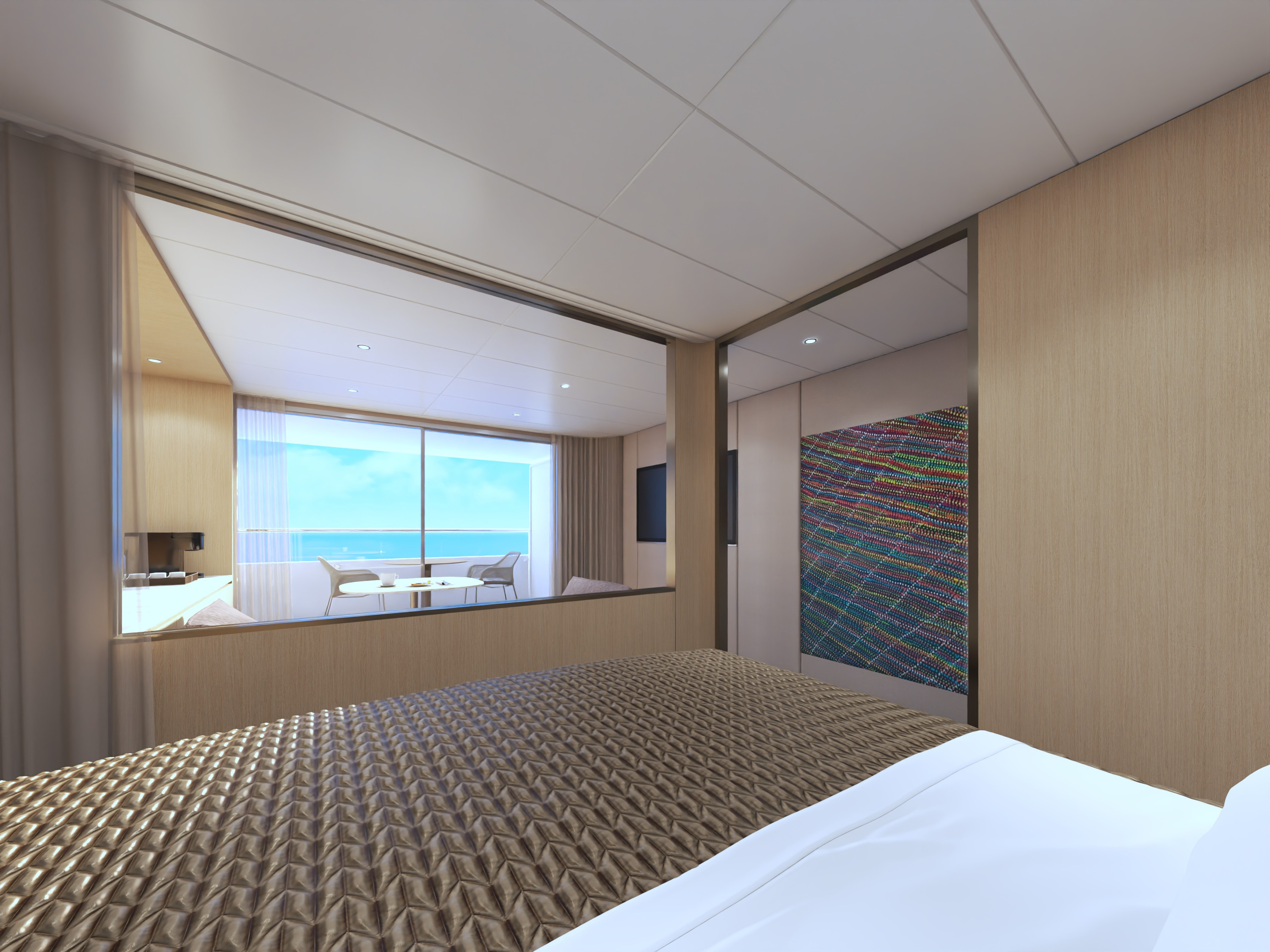
Master One Bedroom Suite
Separate bedrooms for enhanced privacy. Master Suite also offering adjoining suites for family accommodation. Full-size bath, double vanity, walk-in wardrobe, and Glam Bars, ensuring every detail is designed for comfort, privacy, and indulgence.
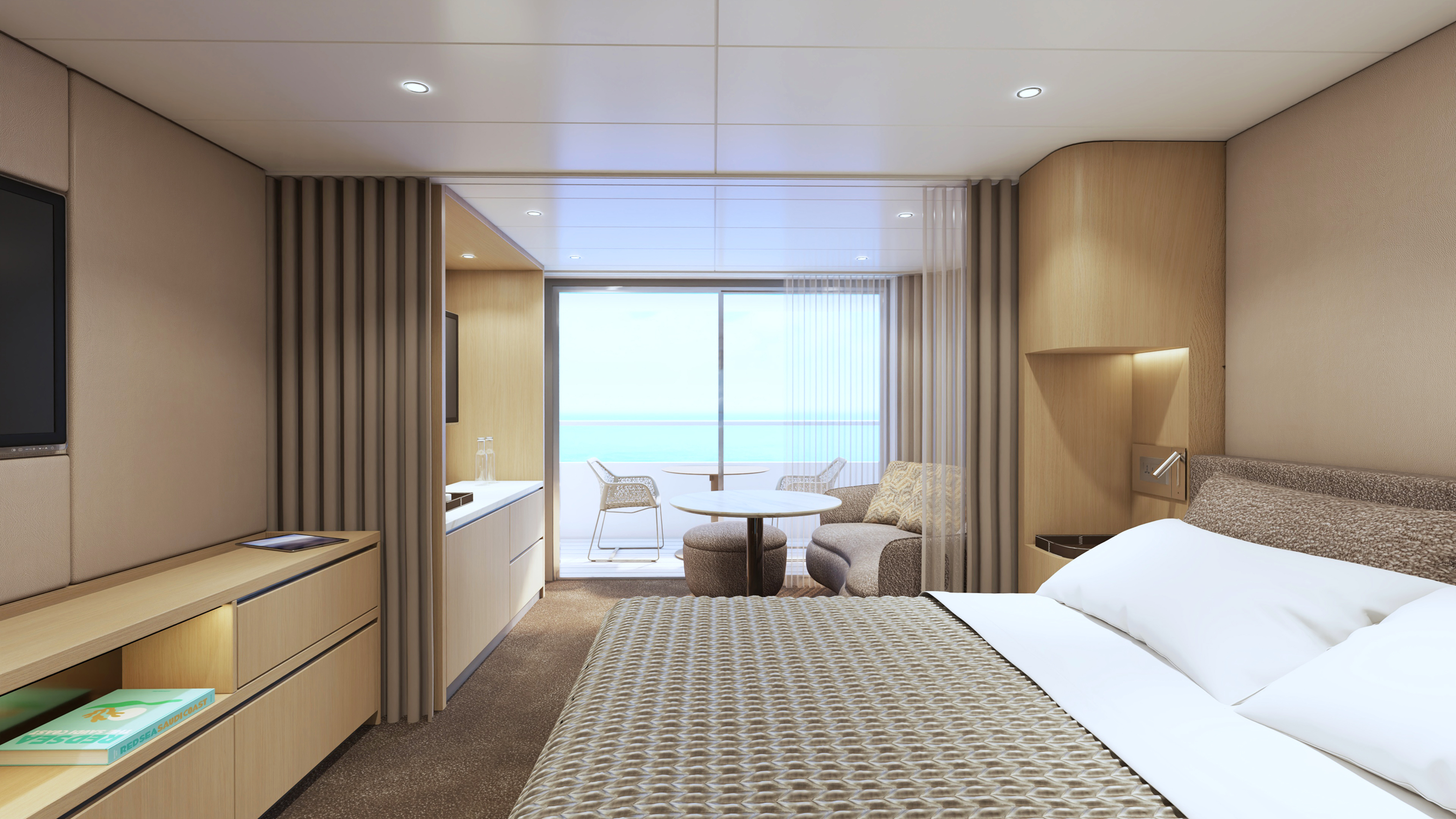
Grand Deluxe Verandah Suite
Separate sleep and lounge areas for the ultimate comfort. Enhanced spaces and elevated amenities. Walk-in wardrobes, Glam Bar, and fully appointed all-inclusive Butler Bars with custom tables for private in-suite dining.

Deluxe Verandah Suite
Separate sleep and lounge areas for the ultimate comfort. Enhanced spaces and elevated amenities. Walk-in wardrobes, Glam Bar, and fully appointed all-inclusive Butler Bars with custom tables for private in-suite dining.
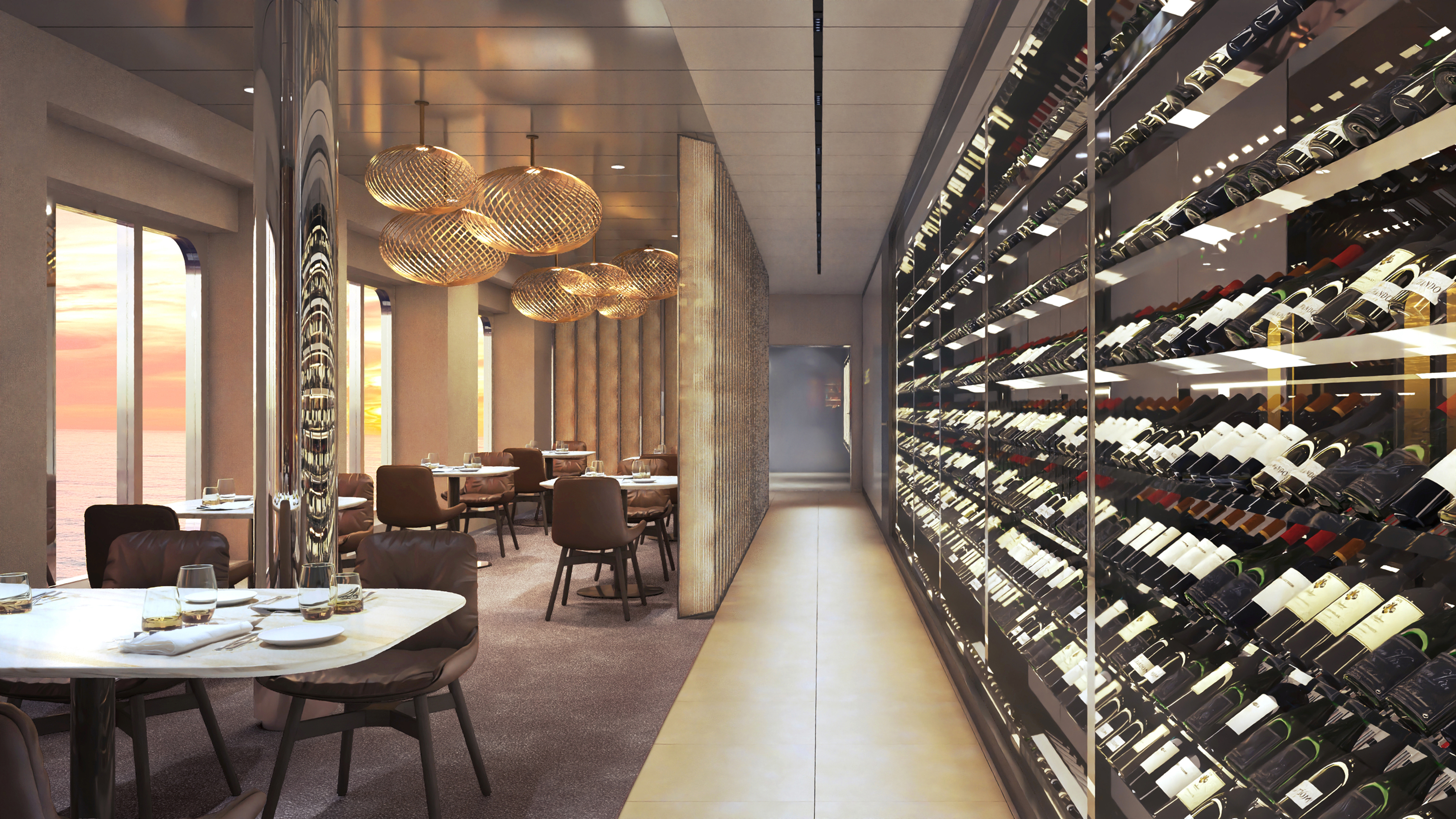
Elements
Expertly prepared Italian classics, premium steaks, and fresh seafood in an elegant yet relaxed atmosphere, with sweeping ocean views, exquisite flavours meet breathtaking scenery.
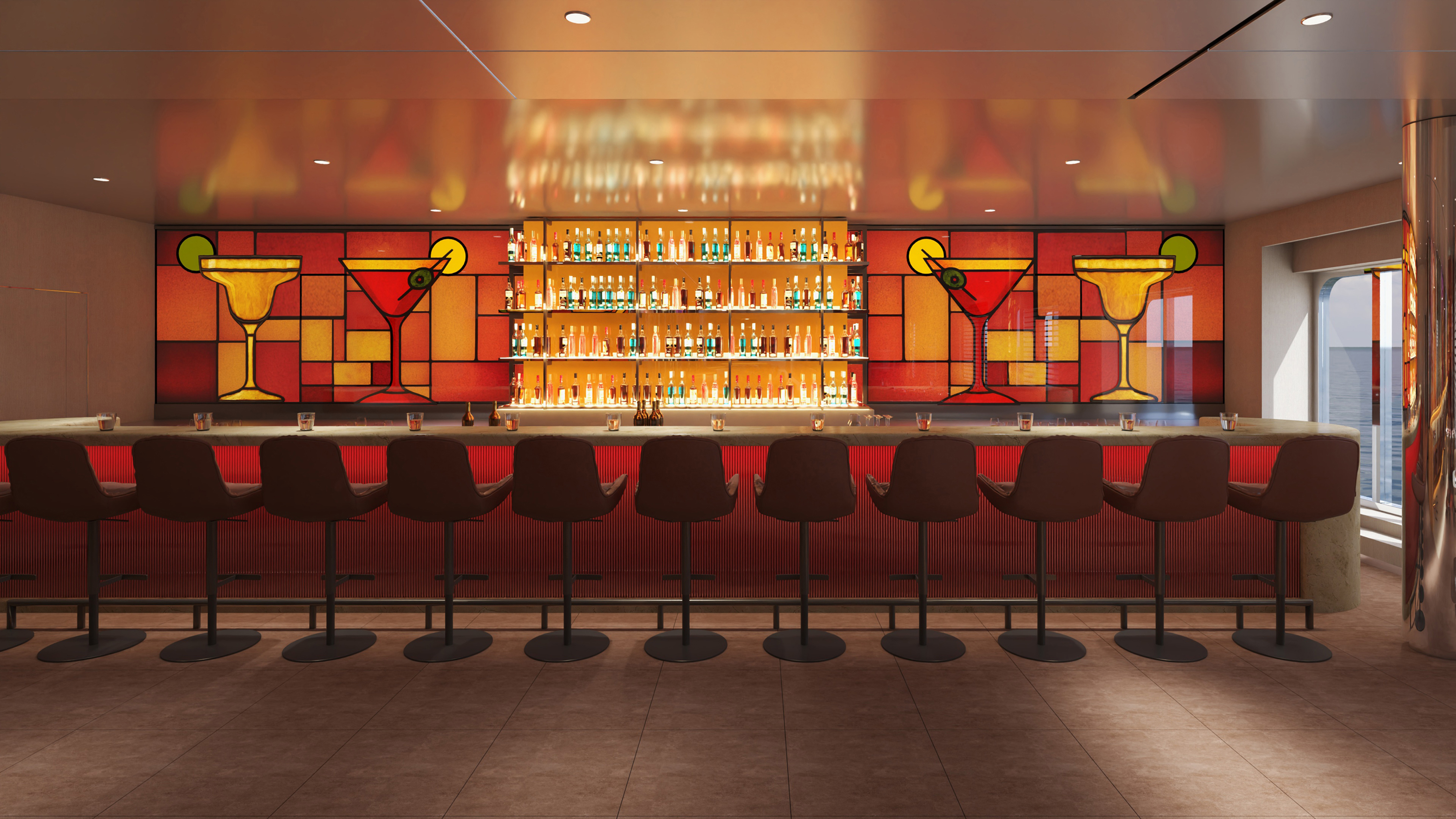
Textura
Expertly prepared Italian classics, premium steaks, and fresh seafood in an elegant yet
relaxed atmosphere, with sweeping ocean views, exquisite flavours meet breathtaking scenery.

Lumière
Fine-dining restaurant, modern French cuisine is elevated to extraordinary heights in an intimate, refined setting, enhanced by an exclusive Champagne experience.

The Yacht Club
A casual dining with a new al fresco terrace – from hot entrées to crisp salads, roast meats, seasonal seafood dishes and artisanal pastries. On special evenings, it transforms into a spectacular venue for gala celebrations, pairing exceptional cuisine with sweeping ocean views.

Azure Café & Bar
Embrace all-day dining with savoury light meals, delectable miniature desserts, hot drinks and premium beverages.

Koko’s Asian Fusion, Sushi & Night Market
For a contemporary twist, these experiences reimagine Asian traditions with dynamic flavours, lively presentation, and an energetic, immersive atmosphere.
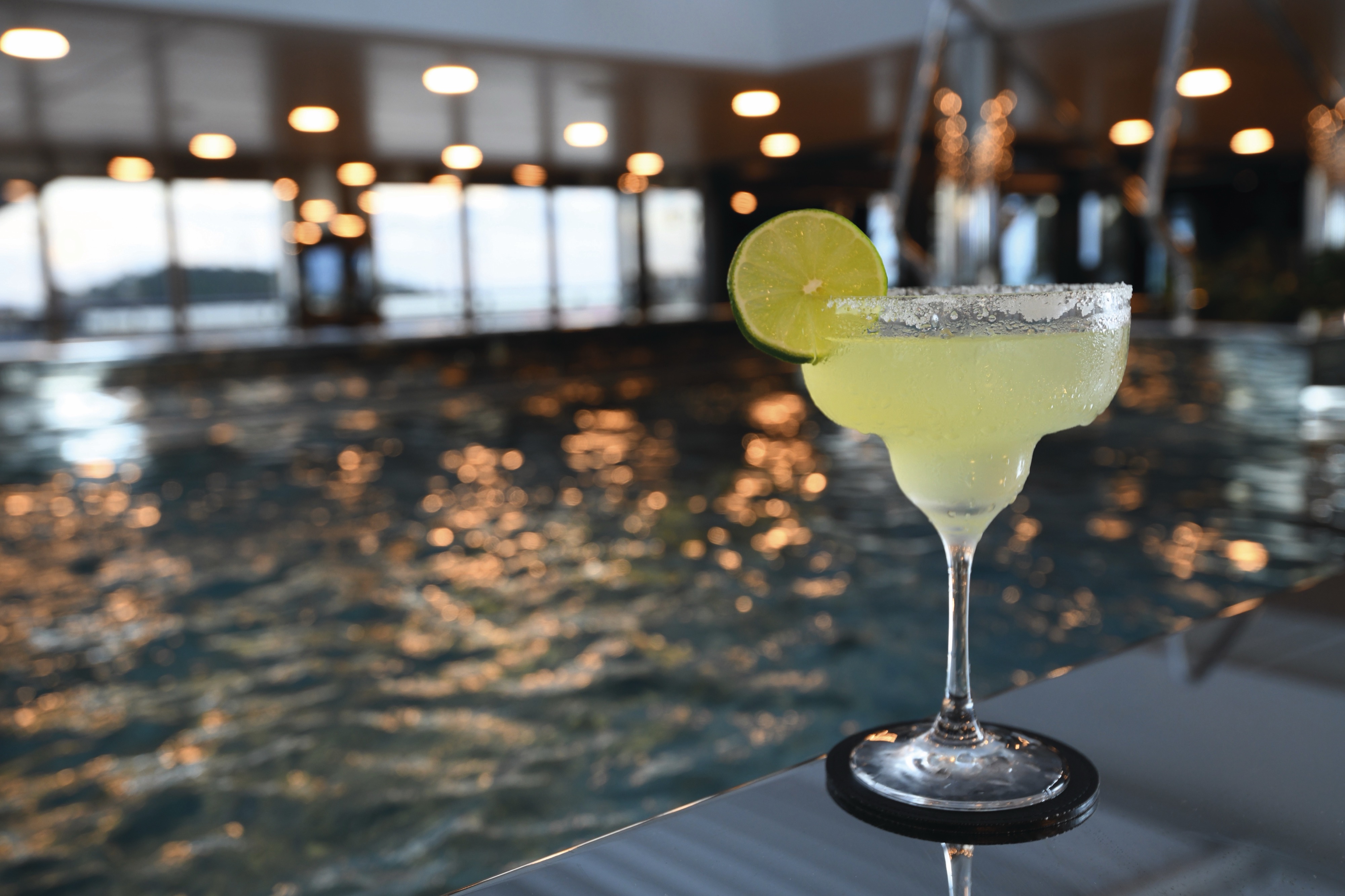
Chef’s Table
A unique culinary concept at sea, this invitation-only dégustation experience showcases the innovative cooking techniques of the Executive Chef.

In-Suite Dining
24-hour room service for all suites.

Summa
Elevates local ingredients in share-style plates.

Crustory
Transforms pizza into a bold culinary exploration.
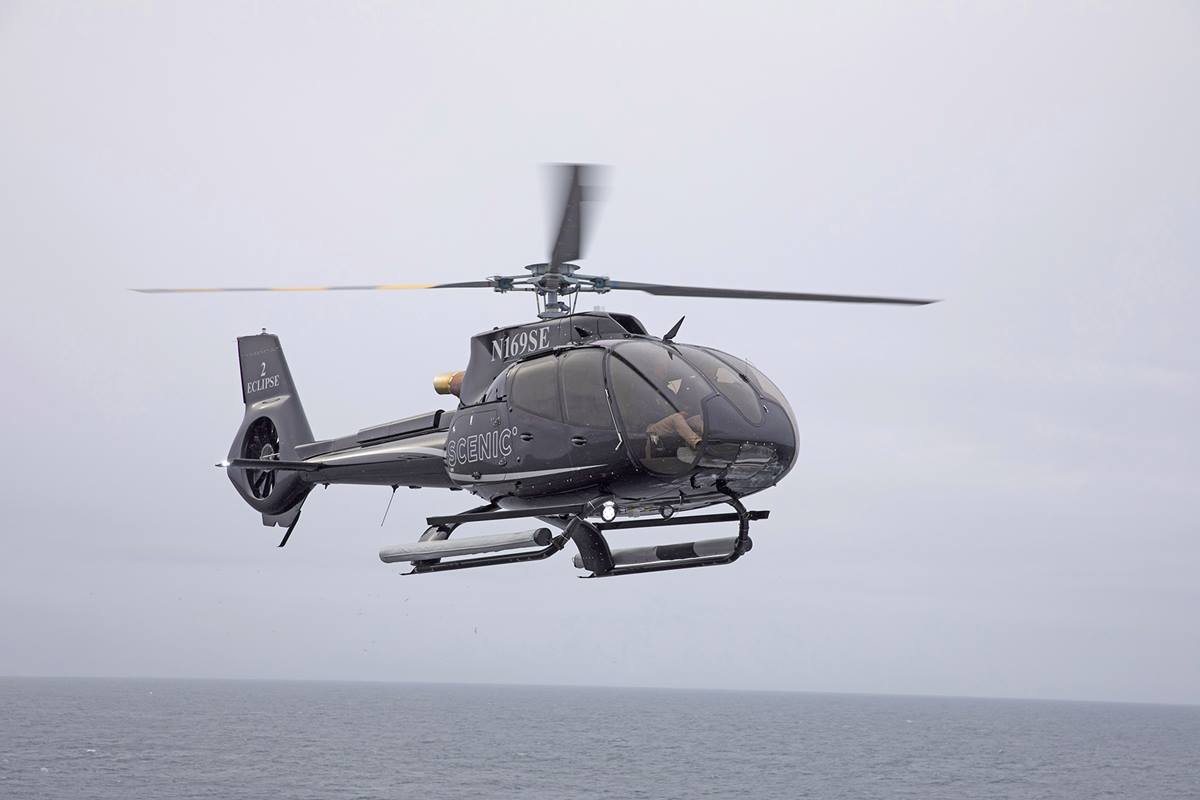
Helicopter Experiences
Two Airbus H130-T2 helicopters for up to 6 guests plus pilot. The quietest in the sky. Outstanding visibility from all seats, expansive windows and large, wrap-around windscreen. Noise cancelling Bose headphones.
Guests can elevate their voyage of discovery to the next level through thoughtfully curated helicopter experiences. With exclusive landings at prestigious golf courses, celebrated local restaurants and special access to historic cultural sites.
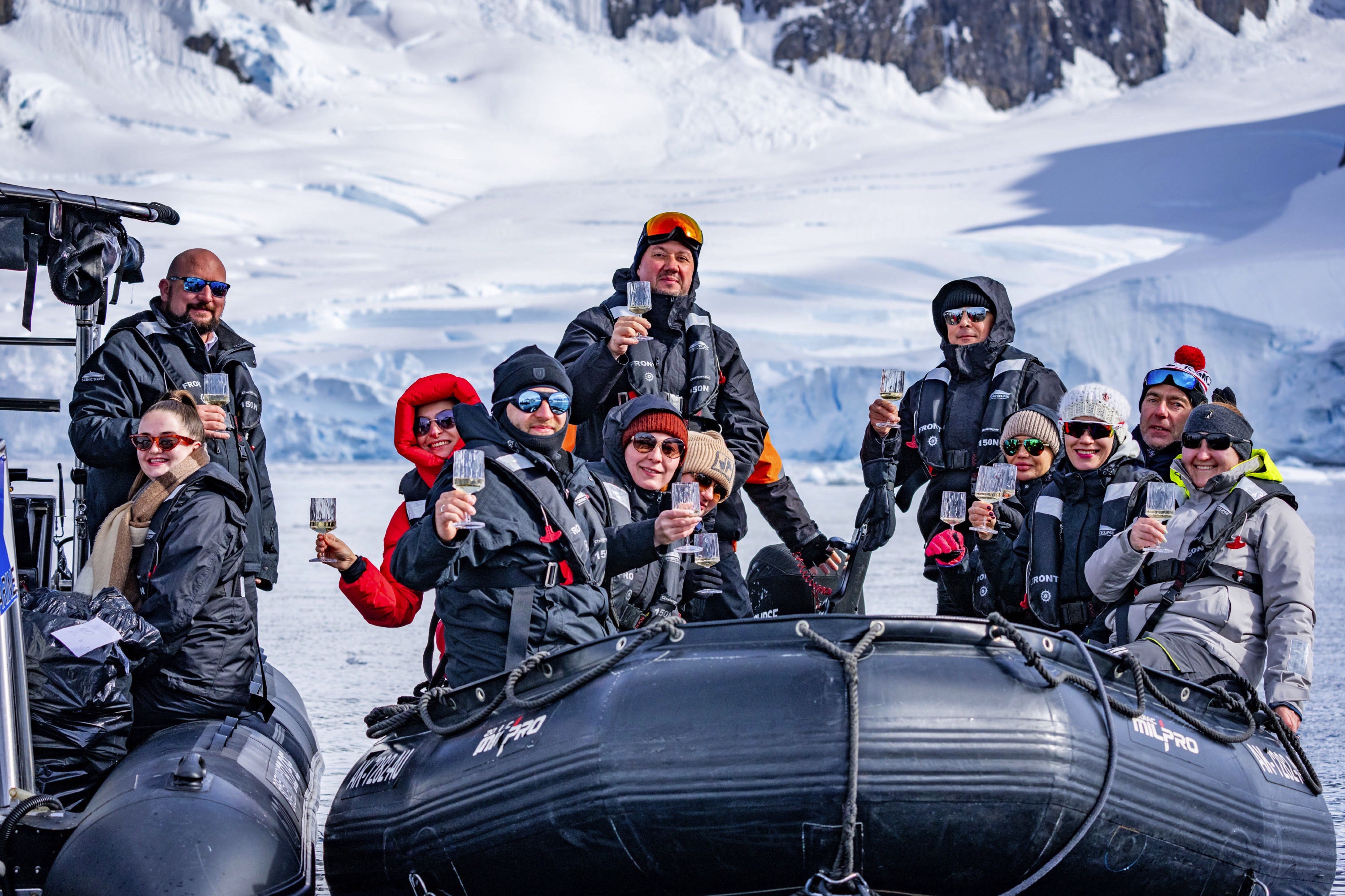
Discovery Team
Led by Director of Discovery Operations, Jason Flesher, the Discovery Team ensures unparalleled exploration and rich cultural immersion on Expedition and Discovery Voyages.
Our team of up to 20 specialists on Expedition Voyages, and up to 15 on Discovery Voyages, spans fields like history, biology, archaeology, naturalism, geology and photography. Enhancing your experience with their passion and expertise.
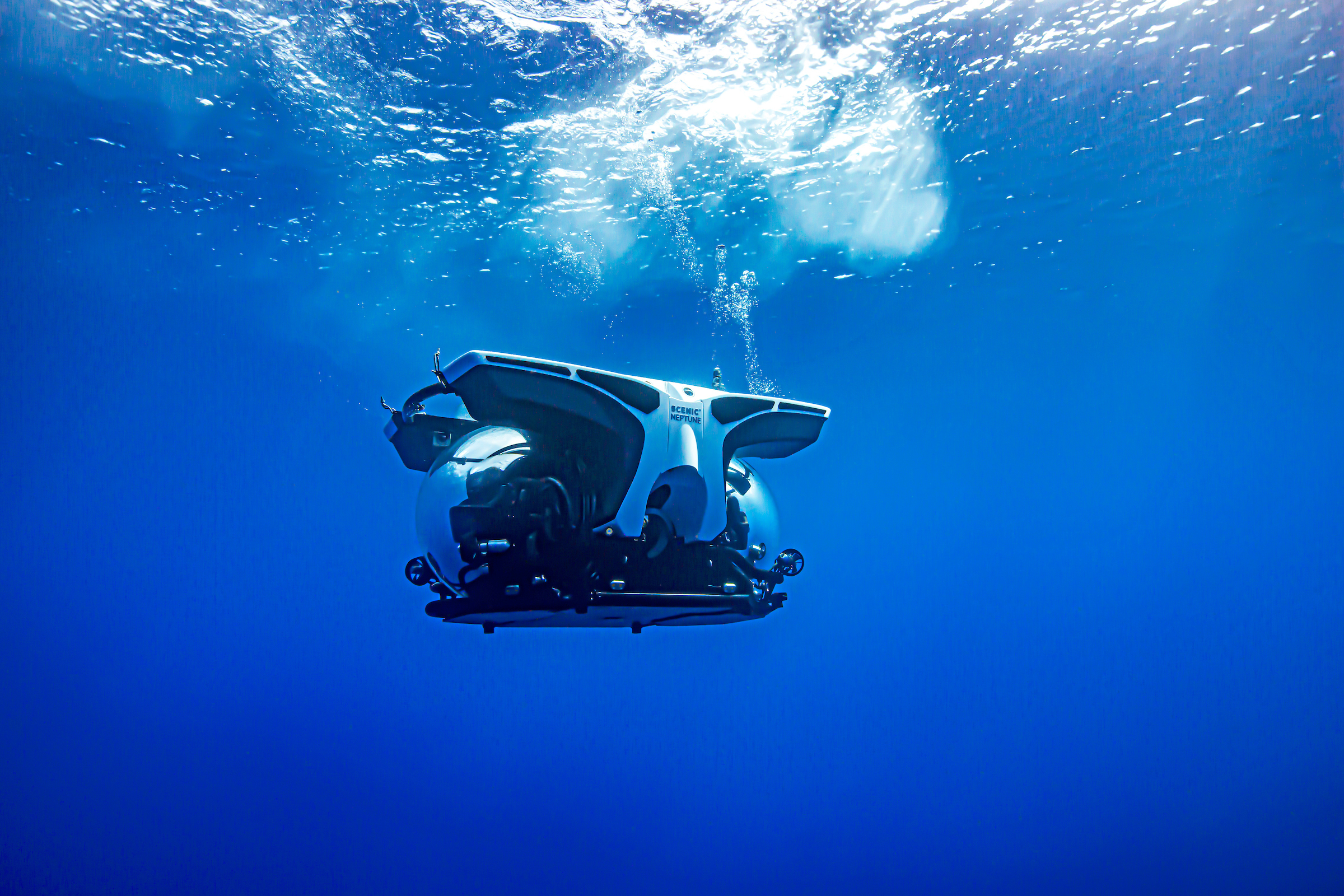
Scenic Neptune
Scenic Neptune III Triton AVA certified up to 200m, dives up to 100m for the best viewing experience. Up to eight guests plus pilot. 360 degree panoramic views, acrylic sphere. Will operate in Antarctica on Scenic Ikon.
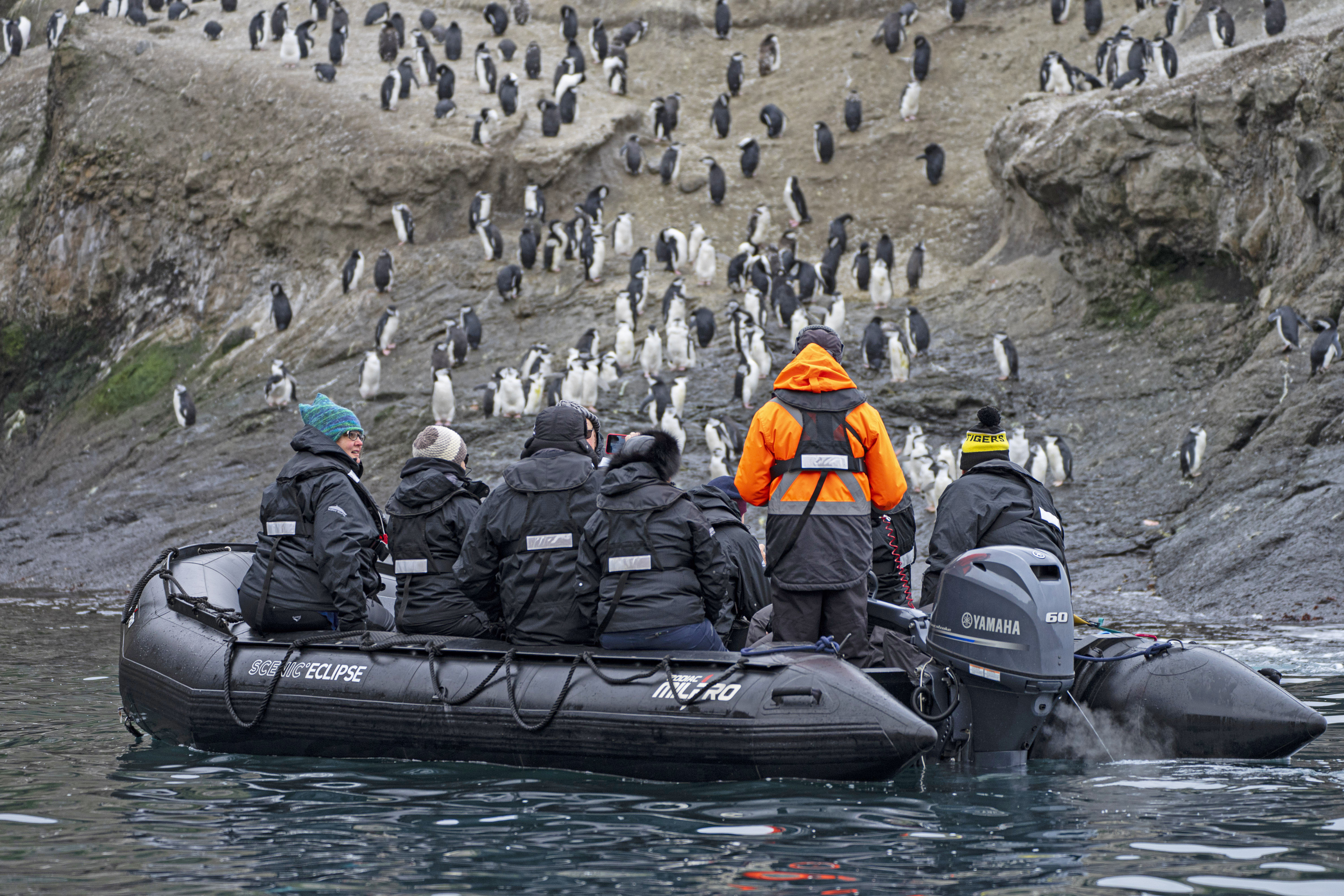
Zodiacs
The Discovery Team are expert operators of our fleet of Zodiacs. On both Expedition and Discovery Voyages the team will guide guests on Zodiac excursions to view stunning coastlines and wildlife, as well as onshore landings.
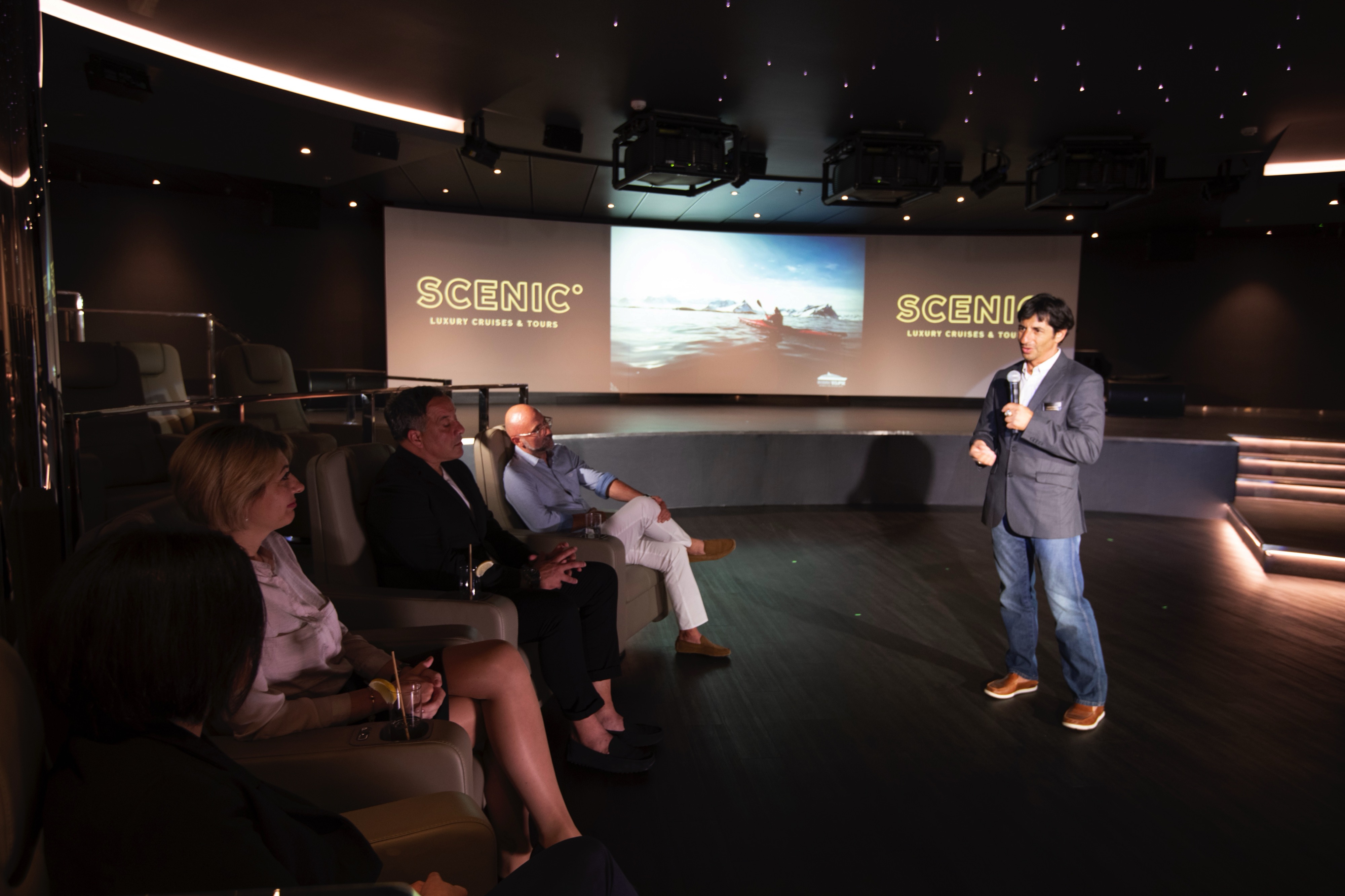
Education Programs
Learn about the unique wildlife, landscapes, history and culture of your destination from our knowledgeable experts during enriching lectures and education programs, hosted in the Discovery Yacht’s impressive state-of-the-art theatre.
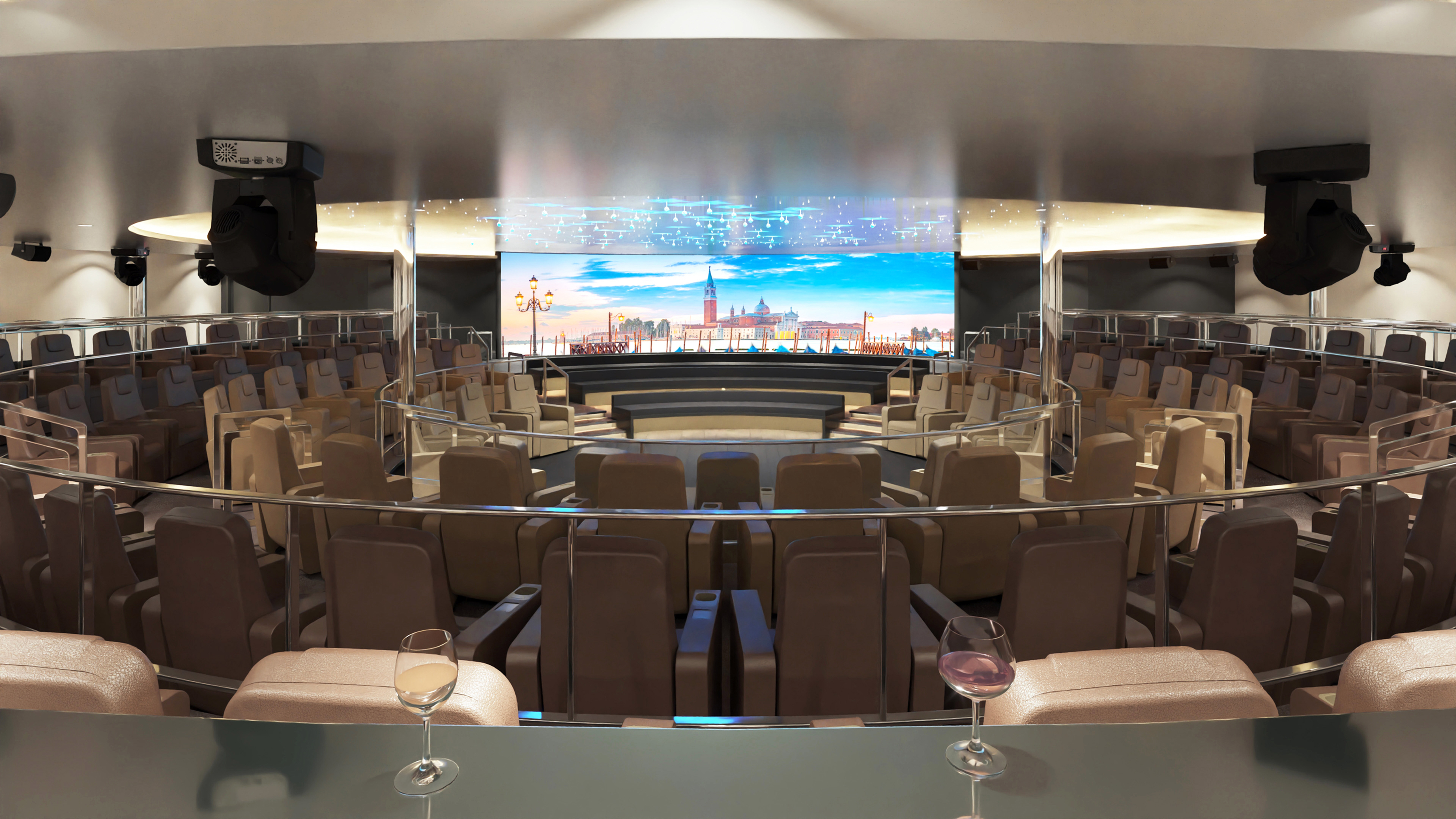
Theatre
Innovative In-The-Round Theatre
Seating for all 270 guests for bespoke shows, culinary masterclassesand Discovery Team presentations come to life.

Unique Open Bridge
To meet the Captain and navigational team, gaining insights into Scenic Ikon’s cutting-edge design and technology. Whilst spending time with the Discovery Team as you search for wildlife and take in spectacular sights along your journey.

Scenic Lounge Bar
Social events and entertainment.

Observation Lounge
Read a book, play board games or relax with a specialty tea or coffee. Spot wildlife through Swarovski telescopes.
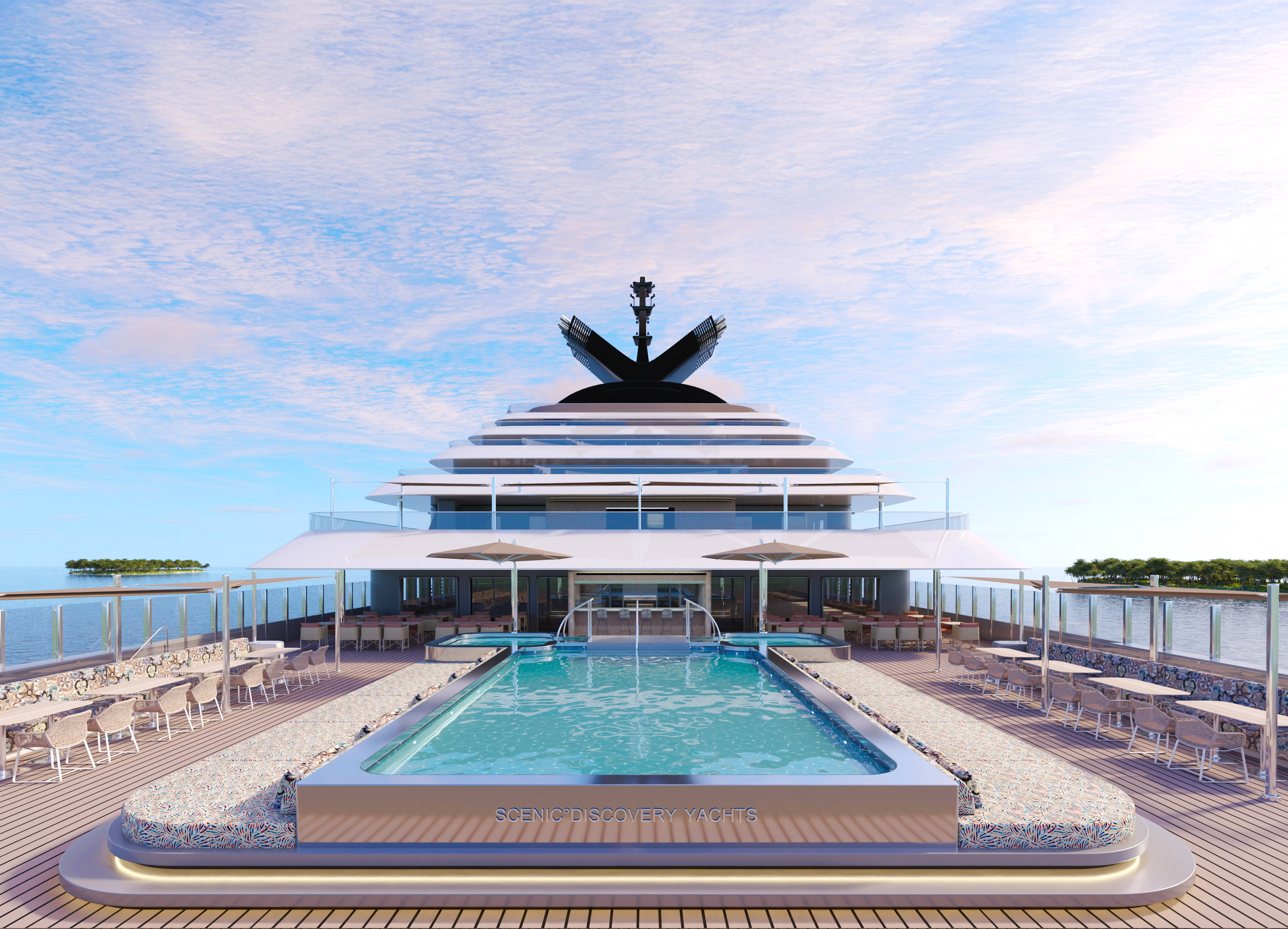
Pool and Terrace
Directly adjacent to Senses Spa. Relax in this tranquil pool admiring the spectacular landscapes, perhaps after a revitalising treatment or yoga class.
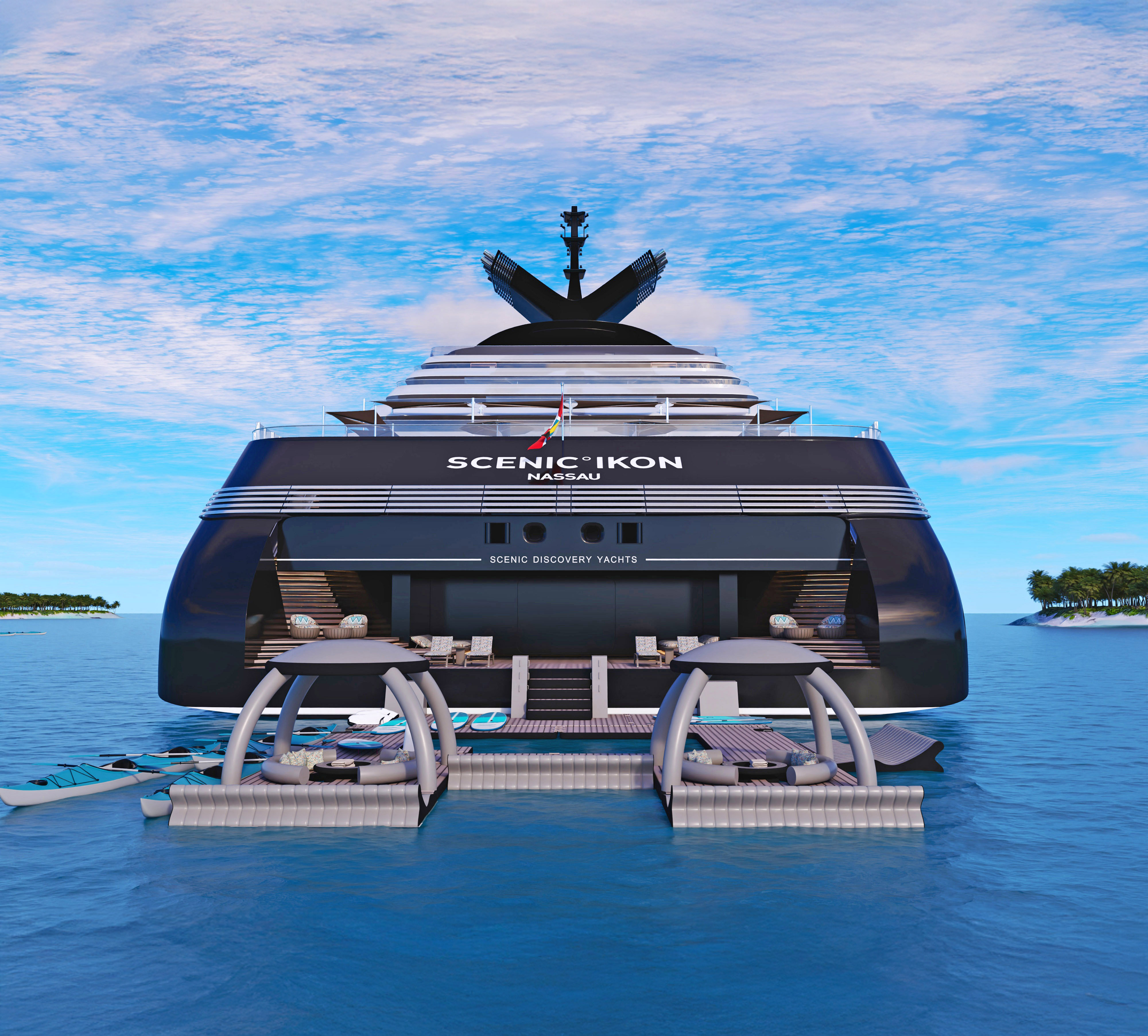
The Marina
A space to relax and exploring coastal wonders at your own pace with an array of water sports – paddleboard, dive with a Seabob, or take a refreshing ocean swim.

Senses Spa
Soak in the serenity with unsurpassed wellbeing experiences. Trained, specialist staff and state-of-the-art wellness facilities on board bring you a cruising experience like no other.

Senses Spa Pool Deck
Step into the rejuvenating Vitality Pool on Deck 6, directly adjacent to Senses Spa. Relax in this tranquil pool admiring the spectacular landscapes, perhaps after a revitalising treatment or yoga class.
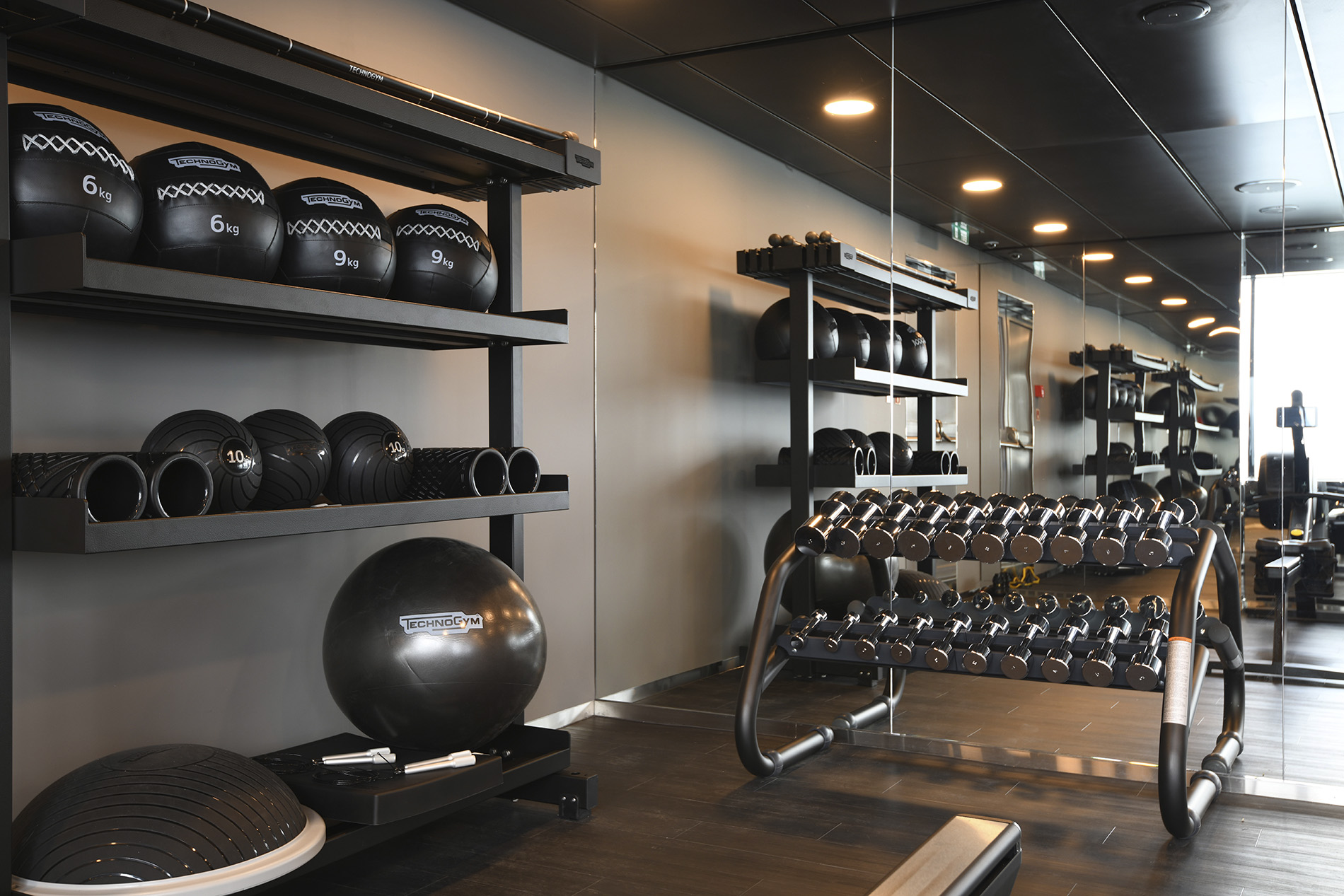
Senses Power Gym.
Keep up your fitness during your voyage in the fully equipped, state-of-the-art gym. Raise your heart rate with a cardio or strength workout as you overlook spectacular ocean views. Train your way or opt for a personal training session with one of our qualified, onboard instructors#.
WI-FI & Internet Access
Complimentary Wi-Fi access is available on board some of our vessels. Please be aware that internet access may be limited or non-existent at certain times due to high demand from other users, or proximity to telecommunication services. We cannot guarantee that you will have full Wi-Fi coverage in your suite.
If you are travelling on a land journey, please note that Wi-Fi is available at selected hotels only.
Smoking Policy
There is a designated outside smoking area on Deck 6 for guests. All suites, including suite verandah’s and terraces are non-smoking.
Special Dietary Requirements
Scenic accommodates special dietary requirements to the best of our ability across our river cruises, ocean voyages and land journeys where applicable. If you have special dietary requests, please notify us at the time of booking and inform your Cruise Director when you arrive.
Please note: while we do our best to accommodate all dietary requirements, special requests are not guaranteed and failure to meet any request is not a breach of contract on our behalf.
If your question has not been fully answered, please get in touch via our Contact Us page.
Dress Code
When you are relaxing on board, the dress code is smart casual and comfortable. Do not forget your swimsuits and exercise attire for the heated pools and plunge pools, the wellness areas and the gym, yoga and Pilates studio.
For evenings, while there are no formal nights, the recommended o board dress code is elegant casual for most restaurants. Suggested attire for women includes a dress, skirt or trousers with a sweater or blouse, and for men, trousers and a collared shirt. A tie and jacket are optional, but not required.
Children
Luxury expedition-style cruising is not recommended for children under 12. Guests under the age of 18 years must be accompanied by an adult and must share their accommodation with an adult. No children’s programs or babysitting services are available on board.
Visitor Policy
In selected ports on request, visitors may be allowed on board. Visitation is not permitted on embarkation and disembarkation day. A visitor form is to be completed prior to the cruise. The guests will be informed once approved. Visitors will receive a visitor pass at ship’s gangway after they provide photo identification. Visitors will need to be accompanied at all times.
Our Commitment to a Sustainable Future
At Scenic, we are committed to ensuring the pristine destinations and communities we visit retain their wonder. We’ve invested in state-of-the-art technology and sustainable initiatives to leave as small a footprint as possible.
- State-of-the-art technology: The GPS Dynamic Positioning system allows the ship to maintain location without dropping anchor onto the sensitive seabed. Our highly efficient engines reduce noise and vibrations for minimal disturbance to the wildlife.
- Biosecurity: We adhere to IAATO and AECO protocols, ensuring that both our crew and guests maintain a safe distance from wildlife and strictly follow biosecurity guidelines.
- Efficient fuel and engines: Advanced emissions technology and IMO low sulphur fuel.
- Wastewater treatment: Advanced treatment systems to ensure minimal impact on local ecosystems.
- Plastics Reduction: We are committed to reducing our environmental footprint, with our ships already over 95% single-use guest plastic-free.
- Local sourcing and on board herb garden: We source from local markets wherever possible, and maintain an on board self-sufficient herb garden, significantly reducing waste and transportation-related emissions.
- Conservation education: Educational program that fosters a deeper understanding of the environments we visit.
Language
The official language spoken on board is English. All officers, staff and crew as well as local guides and regional specialists speak fluent English. All announcements and lectures will be presented in English.

Deck 10
- Smoking Area
- Elevator
- Cabanas
- Sky Cocktail Bar
- Sky Deck & Pool

Deck 9
- Chairmans Club
- Elevator
- Ikon Penthouse
- Scenic Yacht Suite
- Horizon Suite
- Signature Spa Suite
- Deluxe Verandah Suite

Deck 8
- Experience Pool
- Senses Rejuvenation Spa
- Strength & Endurance Gym
- Elevator
- Grand Terrace Suite
- Master One Bedroom Suite
- Grand Deluxe Verandah Suite
- Deluxe Verandah Suite

Deck 7
- Spa Vitality Pool
- Senses Rejuvenation Spa
- Yoga & Pilates
- Elevator
- Balance & Flexibility Gym
- Wheelhouse
- Master One Bedroom Suite
- Grand Deluxe Verandah Suite
- Deluxe Verandah Suite

Deck 6
- Azure Dining Terrace
- Crustory
- Azure Bar & Cafe
- Lumiere Dining
- Alkemia
- Elevator
- Observation Lounge
- Helideck
- Observation Deck
- Deluxe Verandah Suite
- Grand Deluxe Verandah Suite
- Master One Bedroom Suite

Deck 5
- Pool & Pool Terrace
- Yacht Club Bar
- Yacht Club
- Elevator
- Master One Bedroom Suite
- Grand Deluxe Verandah Suite
- Deluxe Verandah Suite

Deck 4
- Summa Dining
- Textura Dining
- Night Market @ Koko’s
- Elements Dining
- Koko’s
- Chef’s Table
- Sushi Bar @ Koko’s
- Elevator
- Guest Service
- Reception
- Main Lounge
- Scenic Bar
- Boutique
- Theatre

Deck 3
- Marina
- Marina Lounge
- Elevator
- Discovery Centre

